#which is of course just basic love symbolism since fire is often associated with love and sexuality
Explore tagged Tumblr posts
Text
Time to talk about the flower shirt
You read the title. Time to talk about this.

This is the infamous flower shirt Thomas put on in his store and, since the fandom is the fandom, everyone started to speculate about those flowers.
At first, I didn’t want to do it. They’re just flowers and other people already talked about them, so what could I possibly add to the conversation?
But while I was writing about Orange, I had to talk a moment about the orange flower. It was supposed to be a small parenthesis, just a couple of words about that.
But then I looked at the other flowers and what other people told/not told about them and how some didn’t find Patton’s flower... so here I am, adding my two cents to this theme.
You needed it? Probably not. Well, I’m writing it anyway.
So let’s take a closer look at those flowers and see each one in detail:

__________________________________
Roman: Red rose

Should I really explain why it’s perfect for Roman? Red roses are the universal symbol of love. Basically in all cultures red roses symbolize passion, true love, romance and desire. Also, according to this website, even the shade has a meaning! In fact, the deeper the red shade is, the stronger is the passion.
And even the number of red roses has a meaning! In this case, we have only one single red rose and that "represents love at first sight, or if it’s coming from a long-term partner, they are saying “you are still the one”.”
You know what that made me think? About Thomas telling Roman “You’re my hero”. A perfect symbol that he was “still the one” for Thomas.
__________________________________
Orange: Lantana camara
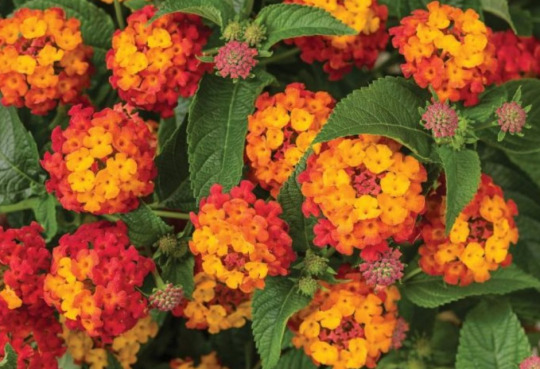
This is an incredibly peculiar flower.
Lantana Camara symbolizes severity and rigour. And this alone can be analyzed in all possible ways, but there are other interesting details about this plant I think it's worth mentioning.
Lantana is toxic for livestock, such as cattle, sheep, horses, dogs and goats. According to Wikipedia, previous studies suggested it could be toxic for humans too, especially the green unripe berries. However "other studies have found evidence which suggests that its fruit poses no risk to humans".
Lantana is a freaking invasive plant. In some areas, it's so predominant, to reduce biodiversity, because its presence "can significantly slow down the regeneration of forests, by preventing the growth of new trees". Also, as if this isn't enough, this plant can also produce toxic chemicals which inhibit other plant species.
Lantana has also a great adaptability, that helped it to be so invasive: it can live in a wide range of different environmental conditions, it can survive long periods without water, heck it's even resistant to fire. It's not a plant you can underestimate. Like Orange, I assume.
But Lantana isn't just an invasive plant. Lantana has always been used for medical purposes, because it showed good antimicrobial, fungicidal and insecticidal properties and its extract helps against respiratory infections and ulcers.
Also, since it doesn't have many pests or diseases, lantana became a common ornamental plant. It even attracts butterflies!
In other words: isn't that the perfect plant to symbolize the double nature of a dark side? It can be a threat, change the environment, destroy and even kill. But it can also be a medicine, something useful, something beautiful.
Whoever Orange is, Lantana camara tells us that, whithout a doubt, he’s a dark side.
__________________________________
Janus: Sunflower

Do you think Janus isn't perfect enough as he is? Do you think there's not enough husband material in the snek?
Well, you’re wrong and the sunflower is here to prove it.
Sunflower symbolizes loyalty, adoration, longevity, vitality, worship. Now add this up to the sunflower’s behaviour and how it follows the sun... and you’ll get Janus. Janus literally acts like a sunflower: Thomas is his sun and everything Janus does is for him. His whole existence is centered around Thomas.
But we already knew that, because it's the same message that shone through his playlist. Everything about Janus tells us how much he adores Thomas, from his canonical behavior in the series, to his playlist, to this flower.
Oh, do you need another proof that this is flower is perfect for Janus? Some societies use sunflowers as religious symbols. Ah, some good ol' reference to religion: it’s like being in his playlist all over again.
And, of course, sunflowers are used for a variety of reasons, like cooking oils, skin care and so on. Even the flower says self care.
This man is perfect.
__________________________________
Remus: Green chrysanthemum
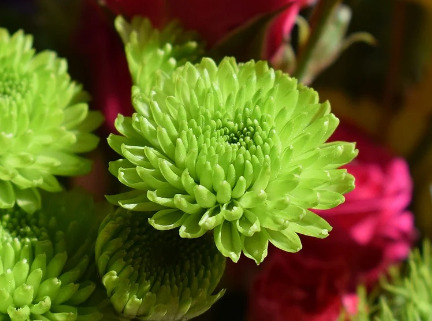
Here's another interesting flower.
Chrysanthemum symbolizes death and it’s the typical flower used for funerals. And I thought this was its universal meaning. It was perfect for Remus just like that.
But then I found out that Europeans use chrysanthemums for funerals and to honor the dead. This flower actually has a whole lot of meanings, some completely different from this.
In China, for example, chrysanthemums are associated with wealth, prosperity and long life. Also they're symbols of new life and reincarnations, so they're the perfect gift for old people or newborns.
While in Japan chrysanthemums are symbols of power and royalty. And that's even more fitting for Remus, because he's a Duke, so he is royalty.
But chrysanthemum also symbolizes friendship - and not just "a friendship", but a meaningful one. It's a symbol of loyalty, devotion, romantic/platonic love and, in general, positive energy. It's a flower with an incredibly strong meaning, so it can't be given too lightly.
And this makes it even more perfect for Remus. It's a flower with a huge plurality of meanings, it's both associated with life and death, it's powerful and it's royalty.
Also, you can eat it. Isn't that the perfect Remus flower?
(On a side note: please notice how chrysanthemums and sunflowers are both associated with joy, loyalty and devotion. I would have never considered "joy" a common trait between Janus and Remus while loyalty and devotion... well, they both care about Thomas and his career and they both work for him despite not being accepted, so I can see why those are common traits.)
__________________________________
Patton: Nemophila

Surprise surprise, this flower wasn't easy to find. I’ve never heard of it, so I had to search among endless lists of blue flowers, hoping to find one that would perfectly match the one on the shirt.
And that’s how I found nemophila.
First of all: nemophila is also known as "Baby Blue Eyes" and it's an extremely rare color to find in nature. It’s very famous in Japan, thanks to the Hitachi Seaside Park. Open this link: it’s a literal sea of blue and it’s absolutely gorgeous. Of course, it attracts people every year.
Nemophila represents prosperity, congratulations on success and victory. Not the first things you would associate with Patton, right?
Well, while I was searching more informations about this flower, I found out this website about the essence of Baby Blue Eyes and the passage I quoted down below has the exact same words you can find on that link:
With its pronounced affinity for water, the Baby Blue Eyes flower essences addresses qualities of tender sensitivity, innocence and trust associated one’s early childhood relationship to the father, or other significant masculine figures that are in some way disturbed.
Very often the father was absent, or there was a lack of support or genuine presence. The Baby Blue Eyes type attempts over time to cover this wound of vulnerability with a false “hardening,” such as emotional distancing, mistrust, cynicism or spiritual alienation. It is a flower that can be equally helpful for men or women, although it is especially needed for many men who struggle to become strong, by disowning their pain.
So nemophilia’s essence has qualities associated with childhood, to the father figure and attempts to “repress” and hide emotions.
That’s Patton. That’s him, period. The childhood-related emotions, that are linked to Patton’s longing for “a simpler time”. The mentions of a father figure - who migh be absent or showing lack of support (like, idk, suggesting you should die so your friends live?). And the attempt to “cover the vulnerability” doesn’t remind you anything? Like the Nostalgia episodes?
This flower is Patton.
__________________________________
Logan: Blue petunia
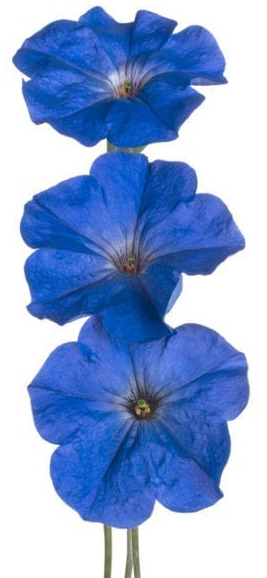
I would like to say, from the bottom of my heart, a huge "FUCK YOU" to this flower, because I spent TWO DAYS searching all the blue flowers in the world and all possible variants, asking myself why this goddamn flower looked so familiar and why it was so hard to find. Blue isn't even a common color in nature, so why couldn't I find it?
I've learned more about blue flowers in these two days than in my entire life. I've searched among flowers I never saw before, like glandora diffusa, leschenaultia and omphalodes verna. I was so desperate to consider this flower a new species, with the petals of a bellflower and the corolla of a morning glory. I even found a goddamn chinese variant of the morning glory that was somehow similar but not that much and why, WHY this was so hard to find?!
And then, after two days and a lot more desperation, I remembered: my dear friend @reptilianwithscallions told me about a post they made, regarding this shirt and the flowers. Maybe they had some idea about Logan's flower?
Well, let's all thank my saviour and this post, because otherwise I would've kept searching until the end of my days.
Long story short, Logan's flower is a fucking blue petunia.
And it's a very peculiar choice, because petunias have multiple meanings, several of which can be contradictory.
In general, petunia symbolizes anger and resentment. It reminds someone that you're still angry or disappointed by their actions and you haven’t gotten over the things that caused these feelings.
Oh my, I didn't know we were back in Logan's playlist. It's basically what he kept expressing towards Thomas with his songs: that he was angry at Thomas for his decision, that he doesn't approve that Thomas hasn't "a real job" and so on. Petunia is a flower that screams passive-aggressive, so it's perfect for Logan.
But petunia's meaning deeply changes, depending on the color of the flower. And while petunia in general symbolizes anger, a blue petunia is a symbol of peacefulness, intimacy and deep trust, shared between two or more people. It's so wholesome, because the deep trust reminds me - again - of Logan's playlist and how it ended: no matter what, he and Thomas are always best friends.
Also, petunia flowers have even a secret meaning behind. Since they’re also gifted to new neighbors or to people who have just moved into a new home, they represent a perfect welcome and a way to express affection and kindness to others.
You’re lucky to be so wholesome, you tricky flower.
__________________________________
Virgil: Perennial Geranium
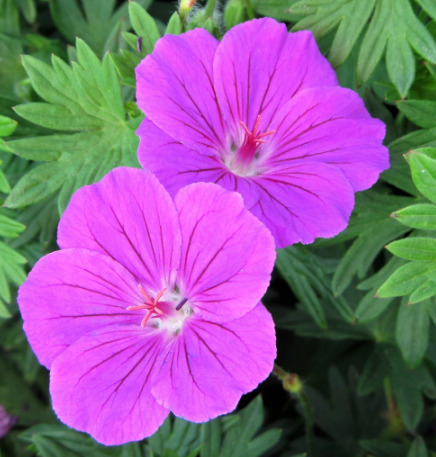
Geranium is a confused flower.
Some of the other flowers have conflicted meanings, but not as much as this flower. These are the most common meanings I found:
Folly or Stupidity
Gentility and kind nature
Clever minds
Ingenuity
Melancholy
Perfect gift for a bride
You can gift it to someone with whom you have planned a meeting
You can gift it to someone with whom you haven't planned a meeting, just to make them feel welcomed
True Friendship
See? It’s confused.
Aside from jokes, this variety of meanings is due to its great diffusion: since geraniums grow everywhere, every culture gave them a different meaning. And sometimes these meanings depend on the situation too.
Awww, isn't it perfect for Virgil? He can be good and bad at the same time. Anxiety can be bad for Thomas and detrimental for his life, but it can also be the alarm Thomas needs. It depends on the situation.
And, just like geraniums in general symbolize positive emotions, happiness and friendship, so Virgil is in general a good guy. All he does is for Thomas' wellbeing, not against him.
And this is confirmed by the vast use of geranium's essential oil. It's one of the most popular and it has a ton of properties: anti-viral, anti-bacterial, anti-inflammatory, anti-depressant, decongestant, relaxing and so on. Just like our Virge boy can be incredibly useful under the right circumstances. (Did someone say "Flirting with social Anxiety"?)
Also, geraniums are simple, humble flowers that usually grow outside, but then we take them and make them part of our homes. Once again, it’s Virgil: he's an outsider, he's humble, he talks bad about himself - but Thomas and the others took him and made him part of the famILY anyway.
__________________________________
Thomas: Cherry blossom
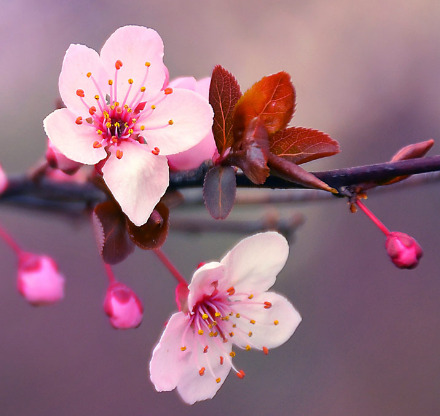
I searched this flower everywhere and the only one that looks like the one on the shirt is the cherry blossom. Why did Thomas make a cherry blossom with eight petals, when they all have five? I have no idea. Is this a different flower, maybe? Maybe, but I’m done: I've looked at enough flowers and I don’t have any strength left.
As you probably already know, cherry blossoms are extremely important in Japan. They're beautiful, they're everywhere and they're meaningful.
Why? Because cherry blossoms are considered the perfect metaphor for human existence. When they blossom it's a pink ocean, a party, people go to admire them - but they’re short lived, because in two weeks, the blossoms start to fall. It's just like human life: a small, rich, glorious parenthesis in the void. Something little and precious that ends soon.
But cherry blossoms also symbolize rebirth, optimism, hopes and dreams. When they bloom, it means springtime is coming and spring has always been associated with renewal.
That’s a very good choice for character Thomas. He’s basically a cherry blossom, the whole series is: something that reminds us how beautiful life is, how multi-faceted, how important. Just like Thomas' single being encompasses seven different sides of himself, so life presents a wide range of choices, of aspects, of flavours. All beautiful, all worthy of appreciation, no matter how different they can be from you and your experience.
And this becomes even more important, in relation to the passage of time and the transience of life. Because life is short and, after that, there won't be any more time to appreciate anything.
In addition to that, I would like to point out how the theme of passage of time is something we already saw in the series. And not just one time, but several. Since the first season, we have episodes all around the concept of growing up, growing old, not being a child anymore, becoming an adult. And the last Aside keeps going in this direction. It's clear this is a big theme and its connection with the cherry blossoms proves it.
But why is the flower so different on the shirt? Because Thomas wanted to mess up with us? Probably. Almost certainly. Once again, thank you Mr. Sanders for making me question everything.
The floor is (figuratively) yours now: if you have any other information, thoughts or opinions, feel free to share them.
_______________________________
TAGLIST:
@willpowerwisps @royalprinceroman @reesiereads @mudpuddlenl @shelby-711 @allmycrushesaredead @aquatedia @sweetkirbi @whatishappeningrightnow @effortiswhatmatters @atlasistryingherbest @bella-in-a-bag @doydoune @miasheer @forever-third-wheeling @mishanthropist @corndot @payte @mcang3l @geekyapollokid @kawaiipotatuh @hypnossanders @idontreallyknow24 @imcrushedbyarainbow @simplyapannightmare @patton-cake
@riseofthewerewolf @frog-candy-bee @bosspotato01 @rosesandlove44 @methaley @sololad @firey-alex @sashootkahoot @chewy-rubies @groaaaaan @croftergamer @misty-the-girlflux-mess @thedevilseyes @arya-skywalker @csi-baker-street-babes @queen-of-all-things-snuggly
@virgildarknessdementiaravenway @mishanthropist @dracayd-universe @unknown-artworks @lonelyfangirl453 @starlightnyx @alienvamp-hesitantflowerface @stubbornness-and-spite @alittletoo-extra @averykedavra @iloveeverytjing123 @bookedforevermore @joyrose-fandomer @anachronismes @the-cloud-14 @mihaela-tbg @igonnatalknothing
@thatoneloudowl @grayson-22 @softangryfuckingdepressed @theotherella @boopypasta @nevenastark @varthandi @floofyconfusednerd @nothing-worth-mentioning @mikalya12 @roses-bubbles @cuter-on-the-inside @coldbookworm @orchidstanslogan @snixxxsmythe @frog-candy-bee @holleratyour-buoyancy @alexowlndra @fadingbagelbananapatrol @our-bloody-mari666 @cxsmospooks @we-need-more-empathy @riverraysong
#sanders sides#sander sides#analysis#roman sanders#ts roman#orange side#janus sanders#ts janus#remus sanders#ts remus#patton sanders#ts patton#logan sanders#ts logan#virgil sanders#ts virgil#thomas sanders#flowers#sander side#sanders sides theory
2K notes
·
View notes
Note
oh!👀 can we have soft headcanons for flowertale outertale and dancetale bros?
Sure! :-D
(also these?? somehow turned out bittersweet at times??? sorry about that idk where THAT came from but I guess I’m a sucker for developing headcanons that stem from headcanoned events that I headcanon happened in my headcanon headcanon)
SOFT OT + FT + DT BROS HEADCANONS
COSMIC (OUTERTALE SANS)
Stargazing is a must for Cosmic. He always watches the stars for a while on Saturday nights. He’d be super happy if you joined him! :-)
Call him star-related nicknames do it do it do it
Will actually die if you pick him up. Please show off your strength. (You don’t actually need strength to pick him up, he’s really lightweight, but he’ll still be immediately attracted to you if you can manhandle him. (Everyone can manhandle him. What low standards he has.))
Cosmic is WEAK to animals. He loves all animals so much. Almost as much as Dusk and Aster, even. If you ask to get a cat or dog or heck, even a lizard, or almost anything else, he’ll immediately cave in and allow it because jnsdnjksjdj look at those bbys,,,,,,
His bed is just a big pillow fort. It’s super comfortable so feel free to cuddle :-)) with him :-))) anytime :-))))))))))))
NOVA (OUTERTALE PAPYRUS)
Just like Cosmic, Nova will take you stargazing. He’s a bit more insistent on it - where Cosmic just goes “hey wanna stargaze it’s cool if not tho”, Nova goes “ WE’RE GOING STARGAZING TONIGHT!” - but it’s guaranteed to be a relaxing and fun time.
He’ll pick you up regardless of height, but the shorter you are the more frequently he’ll do it. Unless it makes you uncomfortable, of course.
Nova gives his S/O(s) star/space-related nicknames! Some of them are a bit ridiculous though. It’s hard not to laugh when he earnestly calls you “THE STAR THAT LIGHTS UP THE SKY AND MY WORLD” in the middle of a mundane and normal sentence dfsjkdsjj
This is completely random but he’s a goddamn MASTER at making lofthouse cookies and he makes the icing into a galaxy-pattern somehow. He’ll definitely make you an abundance of them and he’ll customize them into different shapes and use icing to “paint” them especially for you. :-)
MEADOW (FLOWERTALE SANS)
Hand-holding is just… mm yes to Meadow. If you’ve managed to worm your way far enough into his heart to get him to become your datemate (heheh I love the word datemate), he’ll want to hold your hand as much as possible.
He’s touch-repulsed by strangers, but he's not with those he cares for. Actually, he’s the happiest when he’s constantly being touched in one way or another by his S/O or friends (in a non-sexual way that is, obviously lol). It’s comforting to him.
He won’t initiate touch though
He loves being the little spoon!!! Actually he, uh, kind of has to be the little spoon if you’re cuddling because of his cracked-open eye and the flower that grows in the other socket. It can get a bit uncomfortable otherwise.
Meadow would probably like to have a garden where he grows fruit. Not flowers, though, because as beautiful as they are… uh, well. Flowers are kind of a symbol of death to monsters from his universe and especially to him. But he’d be happy to take care of apple trees and things like that!
PEONY (FLOWERTALE PAPYRUS)
Unlike his brother, Peony does want to have a garden of flowers! He knows flowers are kind of a symbol for suffering in the monster world, but… death isn’t always a bad thing. He can see the beauty in it. (Like how a forest will die in a fire, just to grow back stronger and more beautiful than ever.) Everything comes to an end and isn’t that what makes life so precious?
He associates everyone he knows with at least one flower (which is dependent on your personality, your relationship with him and the experiences the two of you have had, among other things). Sometimes he slips up and accidentally calls people by their “flower nickname”! If he accidentally calls you by your assigned nickname and you look happy to be called that, he’ll start calling you that out loud more often.
He really wants to cuddle but unless you’re really careful, it could end up kind of hurting him… so he wears layers of soft clothes to cuddle you in!!! Not only is it super comfortable for you who now gets to basically cuddle a big pillow, but it works great for him too because now it doesn’t hurt if you move since the flowers on him won’t get snagged on anything! :-D
REMIX (DANCETALE SANS)
Early (platonic) relationship: trolling gremlin man
Middle (platonic) relationship: trolling gremlin man but sometimes nice
Far-gone (platonic) relationship: soft nice guy with a troll exterior
Oopsie-he-has-a-crush: where’s the troll there’s only a flustered soft man here
Romantic/queerplatonic relationship: ALL STAGES COMBINED
He’s SUCH a trash gremlin man at the beginning and he’s pranking you and being a royal pain in the ass but it’s obvious he’s not doing it maliciously, he just thinks he’s funny. Don’t tell him he’s right it’ll only encourage him
He continues to be a troll until he starts to develop a crush on you and then suddenly, all is not good in hoola-hoola land
Say “what’s up, pretty boy” and his brain shuts down and he goes “jsdfjbhsdfjdhb”
He claims he doesn’t like to dance (which is partially true - he only likes to dance when he’s all alone) BUT there’s “one dance-move [he] enjoys”. Guess what it is
He wants you to lift him. Always.
Feel free to lift him whenever he won’t complain
(Until you set him down. Lift him again. pls.)
TANGO (DANCETALE PAPYRUS)
Your personal dance-instructor! He’s a very good teacher, too.
Tango is amazing at getting people out of their comfort zones. While he isn’t too pushy, he’s still not too soft on you. It’s a bit scary how good he is at knowing what boundaries not to cross. Like, you’d think he’d slip up and push it too far yet he never does.
(It’s because, like all other Papyrus..es….(????) he has a close contact with everyone's SOUL and sees the best in them, and sometimes, that best is too far away to be pushed to the surface and he’s mastered the art of knowing what is and what isn’t too far.)
He’s got a diary and he has an entire section dedicated to gushing about you <3
#imagines tag#undertale imagines#undertale headcanons#undertale#outertale#flowertale#dancetale#fluff#y/n x sans#reader x sans#sans x y/n#sans x reader#sans#sans undertale#undertale sans#y/n x papyrus#papyrus x y/n#reader x papyrus#papyrus x reader#papyrus#papyrus undertale
93 notes
·
View notes
Text
The Pelle/Dani Receipts, Post Twelve: Runes
Big, huge Hårga hugs and thanks again to @daydreamers for expertise and editing on this post!
So. Runes. Specifically, the Elder Futhark runes, as Pelle tells Dani in the Director’s Cut, the “special little language” of the Hårgans. Throughout the film, runes are insinuated into basically every surface of Hårga and its people. So many tattoo opportunities, y’all. And it doesn’t even technically start in Sweden. Ari stuck a board featuring the whole Elder Futhark alphabet in Christian and Mark’s apartment. You can see it on the bookcase to Pelle’s right in the couch scenes. So, the film’s usage of the Elder Futhark is a deep, deep rabbit hole full of all the multivalent subtext we crave from this film, but they’re also absolutely blaring evidence for the Dani/Pelle ship. Throughout the film, like many of the background details we’ve discussed, the runes serve as a repetitive chorus of their fatedness for each other, but better still, the runes footnote the film’s ambiguous resolution as their genuine happy ending. So let’s dig in.
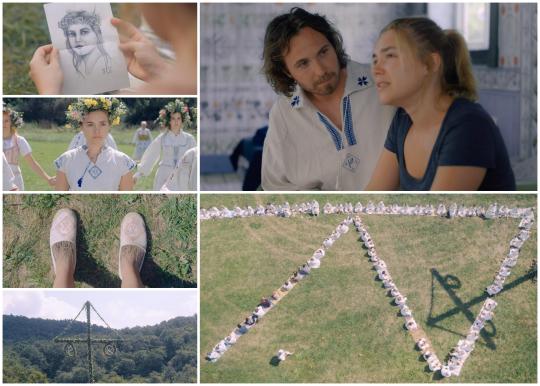
Dani has two main runes associated with her, Raidho and Dagaz, and they are both merkstave versions, that is backwards, lending them a negative reading. Oooooh, scary. Except negative readings aren’t necessarily negative either. All runic readings are subjective and contextual, which is why we decided to talk about these last. Let’s not forget that Dani begins the movie at the bottom of an emotional well.
Raidho, literally ride or wheel, refers to a journey. Yeah, Dani’s on one of those, seems legit. This is the only rune that Ari takes care to point out the meaning of within the film itself, when the elder Arne shows the Rubi Radr to Josh, pointing to Raidho on its side and telling him that that one stands for grief. Grief is a legitimate reading of Raidho merkstave, so let’s just take that interpretation at Arne’s word and combine it with Dagaz, Dani’s second rune.
Dagaz is the last rune in the Elder Futhark, and it means day, symbolizing accomplishment, fulfillment, and new beginnings. As a symmetrical rune, it’s questionable whether it can be merkstave, but Dani’s Dagaz rune (technically runes, as she also has them on her shoes) does lie in opposition. Its negative reading in that case would be hopelessness, blindness, or cataclysmic change. Not fairytale stuff, right?
But Raidho and Dagaz appear together on Pelle’s drawing and on Dani’s dress. Also note that runic inscriptions are read right to left, and the tapestry of the “little love story” is an in-film clue to that reading order. With that in mind, together Raidho merkstave and Dagaz merkstave tell of a big change, even an ending, yes, but an ending to Dani’s grief, and that is what her journey in this film describes. Here, two “negative” readings equal out to a positive in the sense of Dani’s ultimate growth and transcendence. But wait, there’s more.
You will notice the runes on the Hårgans’ clothing, of course, as though they are their personal cult cutie marks, but the embroidered runes are often surrounded by other symbols, esoteric symbols and more complex runic talismans, which deepen the reading of the central rune, like footnotes. In Dani’s dress example, Raidho and Dagaz are flanked by merkstaved Tiwaz runes, with sun symbols above and below. Tiwaz (literally “the god Tyr,” the god of law and justice) is one of the runes featured on Christian’s robe during the sex ritual, and it describes justice, honor, authority, self-sacrifice. Its merkstave meaning then reads as conflict, imbalance, lack of communication...separation. And so, in the specific context of the dance competition, while Dani’s main runes shown in Pelle’s drawing forecast (or possibly straight-up spellcast, depending on your interpretation) an end to her grief, the more complex version she wears for the dance tells of that happening through a conflict and a break...but the sun will come out tomorrow, tomorrow. It is a new dawn for Dani as the May Queen.
Her shoes, which we only see during the dance, are more complicated. First, the embroidery is done in faded red thread, and we know that red appears very selectively on Hårgan garments. Siv wears a ton of red throughout the festival. Maja and Inga also wear striking red additions to their costumes at the Fire Temple ceremony. Ingemar has a single red button on his waistcoat. So red may convey authority, fertility, sacrifice, or even be a brand of shame, but it always seems to mean something.

As for the symbols on her shoes, again we see the merkstave-ish Dagaz rune, but it is alone in the center, no Raidho. So we’re looking at a big change or an ending again. Instead of suns, we have snowflakes, recalling the Spoiler Tapestry in the beginning, the way it began in frosty dark death skullhead weather and ends in summer dinner and dancing beneath the scariest sun since Teletubbies. To the right, we have a bind of three Tiwaz runes, and to the left, we have an Ingwaz (seed) rune, combined with a merkstave Kenaz. The triple Tiwaz is a victory rune, taken from an Old Norse poem where a Valkyrie was woken from her slumber. Three is a holy number, and that’s definitely something we know the 9-multiple-loving Hårgans pay attention to. This rune means the sleeper Dani is about to be awoken through a victory. Meanwhile the Ingwaz rune refers to coming into harmony and reaching potential. It’s also a fertility rune. Kenaz (torch) is a rune that normally describes transformation, knowledge, and the harnessing of light; merkstave, it speaks to darkness, lack of illumination and a relationship breakdown. Taken together, reading right to left, Dani’s shoes basically say: there will be a great change where she will be awoken from her slumber through a victory, she will have a breakup and/or her illusions will be shattered, but that will bring her ultimately into harmony, and there is the added implication of her fertility, bolstered by the red thread, being part of this. THAT IS ON HER SHOES.
For what it’s worth, you will also notice Hanna wearing Dagaz in opposition, like Dani, and the elder Sten wears a merkstave Raidho, in yellow no less. You can peep merkstave Raidho and Dagaz elements on the temple doors, too. So even if you eschew our deep dive here, these runes cannot be looked at superficially, as merkstave = bad = Dani doom. If Dani’s doomed, so is Sten and Hanna and the whole damn Hårga, and you may think that, but it’s not terribly likely they’d write it on themselves, is it? Sten doesn’t look doomed to us. Sten looks quite jolly, actually.
OK, time to obsess on Pelle. Pelle has one rune on his Hårgan tunic that he wears for the majority of the film, Fehu, and this seems more straightforward. Fehu means wealth, specifically mobile wealth, specifically cattle. As we mentioned earlier: moo, Dani; moo, sacrifices. And since Pelle’s the one bringing new blood and their new queen, the association of Pelle with prosperity is quite fitting. Add to that the way Fehu and Raidho tend to pop up all over the village, particularly on the maypole. The maypole combination of Raidho (not merkstave) and Fehu speaks to the way the Hårgans believe the dance around the maypole enacts (and reenacts) a ceremony that brings them prosperity, and having Dani and Pelle as Raidho Barbie and Fehu Ken is just kind of perfect in that light.
Pelle’s Fehu is surrounded by four symbols. Let’s have a crack at those, too. First we have what looks like a closed eye up top. At the bottom, we have a cross. The cross is not actually a cross; it’s a combination of four Isa (ice) runes, and we know this because there are four dots arranged around them, telling us, hey, these are four symbols not one. Then to the right, we have another talisman that looks like a crucified diamond with five dots. Again, the dots mean that these are individual runes drawn as one symbol as a kind of shorthand, so this symbol is actually Ingwaz again, quartered by four Isa runes. Finally, to the left, there is another Isa rune crossing a Tiwaz, and the absence of dots here means that they are a bind, or they are meant to be read as one thing (or are a spell for one thing).
The closed eye symbol is a bit of a guess here; it might represent Pelle’s unclouded intuition or maybe, in view of Dani’s suns and the association of Raidho with the summer solstice, it is meant to symbolize Fehu’s complementary association with the winter solstice. We prefer the association with his intuition given the events of the film. But what about the other symbols? Isa is a rune that describes the self or the ego. On the positive side, it is about will and focus, but on the other side, it is everything bad about ice: rigidity, blindness and self-preoccupation, being frozen. Again, symmetrical runes like Isa don’t merkstave, but they can lie in opposition, and so we have two pairs of Isa indicating, at the right, self-fulfillment, with the added implication of fertility, and coming into unity with the family after the will breaks through the metaphorical ice. At the bottom it is the same reading, only without Ingwaz. Will and self-control overcomes lassitude. And then again, one last time, Tiwaz crossed with Isa, read as one thing, not a series like the previous shorthand symbols, invoking justice and male energy to, again, break through the metaphorical ice. Taken together, it’s a formula for Pelle and the family’s triumph. Governed by his unclouded intuition, Pelle’s will overcomes that of his four differently-blind friends, bringing new blood and justice and unity with the family for the betterment of all, and the two breaks in the rightmost configuration carry the added implication of Pelle bringing into the family Christian’s and Dani’s new blood.
Finally, as discussed briefly in posts 10 and 11, Pelle changes his shirt on the morning of the dance competition, swapping Fehu for Wunjo (joy). There do appear to be a couple flanking symbols on this shirt, too, but we never get close enough to see, so we’ll just have to go with Wunjo’s face value. Again, this is the rune that emphasizes harmony, family, and the art of correct wishing, i.e. wanting (and getting) what is good for you. Pelle wearing Wunjo when he kisses Dani is a sign that he, the anti-Christian if you will, is her wish come true. This choice is not only incredibly positive for his relationship with Dani, but illustrative that there is a difference between Dani/Pelle and Dani/Hårga by virtue of the fact that he changes back into the Fehu shirt for the Fire Temple ceremony. Insofar as Dani is part of the family after the ceremony, the prosperity spelled on his Fehu-emblazoned tunic applies to her, too, but the Wunjo shirt is for her and for her victory...and his victory over Christian for her sake. The implication is that their story will not simply end with Dani assimilated into Hårga. They have special, personal significance for each other. While the ending shots of the film are a little ambiguous, the runes promise the May Queen and her consort are going to be just fine, y’all.
Again, would you like to see our fanfics?
Of course, there’s tons more to explore in the film that doesn’t speak specifically to Dani and Pelle’s love story, and even while we compiled this list, we were continually noticing and discovering the significance of new things. There’s no reason to think that will stop just because we’ve posted the Receipts. Still, we hope that you will enjoy the evidence we have compiled here for not only the legitimacy of the Dani/Pelle ship, but its promise of a happy ending for the OTP because, by Ari’s own admission, for better or worse, Midsommar is a wish fulfillment fantasy.
For more, click on The Pelle/Dani Receipts Masterpost
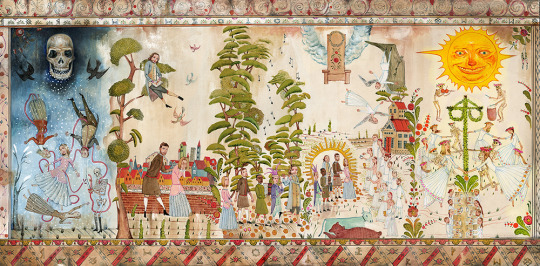
206 notes
·
View notes
Photo

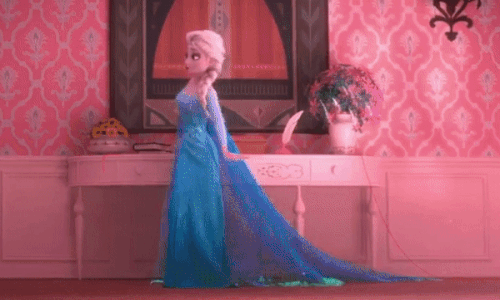

Three of a Kind
Since Frozen II came out, I have been eager to do an analysis to compare and contrast Elsa’s three dress transformations, and here it is at last. You can read more about some potential meanings of the colors of Elsa’s main dresses in both feature films here, and read about her and Anna’s main clothes from the original film in my analysis “Colors of the Clothes”.
Different Dresses
In Frozen, Elsa makes her first dress transformation near the end of her song “Let It Go”. She turns her coronation gown into an ice-made, crystal blue, off-the-shoulder dress with a right knee-high slit, a bodice covered in blue ice crystals, and long, translucent, powder blue sleeves. Attached to the back of her bodice is a long, transparent, pale blue cape decorated with large snowflakes. Elsa’s transformation also causes her tights to disappear, leaving her legs bare, and changes her dark brown flats to ice blue kitten heels.
In Frozen Fever, when Elsa transforms her ice dress into her party dress, its general design remains the same, being off-the-shoulder with a bodice, a right knee-high slit, and an attached transparent cape. But because Elsa uses her magic to freeze pink flowers on different parts of her outfit, the chlorophyll from the stems turns her kitten heels and dress emerald green, the latter of which has light green translucent short sleeves and a bodice covered in teal ice crystals patterned to resemble leaves. The pink flowers decorate Elsa’s sleeves, bodice top, and her now-emerald green cape, which also contains flower and leaf designs.
In Frozen II, Elsa undergoes her final dress transformation towards the end of her song “Show Yourself”. Her pale blue dress becomes a white off-the-shoulder dress with a right knee-high slit and white long sleeves, which have the symbol of the four elements at each shoulder. The color of her leggings change from pale blue to light grayish-blue. Running along Elsa’s chest and down to her waist are different-colored, diamond-shaped ice crystals that represent the four natural elements of fire, water, air, and earth. Her transparent cape fades to blue at the bottom and is split in two parts, as if to showcase her status as the fifth spirit. During her transformation, Elsa also goes from being barefoot to wearing white, open-toe ballet flats.
From Covering up to Coming out of the Blue
When the film introduces her as a child, Elsa is happy, playful, and carefree, and the bright blue nightgown she wears symbolizes these positive emotions. But following her separation from Anna over the next ten years, Elsa’s clothes become darker and duller in color (primarily blue with purple thrown in), and cover the entirety of her body. The dark colors/shades of her outfits and her body being completely covered highlight Elsa’s confinement and isolation from Anna (and the entire outside world), the suppression and concealment of her powers from outsiders (which is also emphasized by the gloves she always wears), and her own emotions of depression, anxiety, fear, and other negative ones that result from her feeling burdened by her struggles to control her magic.
On the day of her coronation, Elsa’s clothing conceals her entire body, from her cape color covering almost her whole neck all the way down to her feet being covered by tights and shoes. Like the clothes we briefly see her wear during “Do You Want to Build a Snowman?”, Elsa’s coronation outfit hiding the entirety of her body represents her concealing her powers from her people. Besides her powers, Elsa is also concealing her real self on this day. As an introvert, she does not like being in the spotlight and sometimes feels shy around people. She is worried, nervous, anxious, and terrified about being the center of attention and can only think about the worst that could happen. When she talks to Anna and tricks her into dancing with the Duke, Elsa shows how warm, playful, and mischievous she can be. But she does it briefly and with restriction, then she becomes closed in again to avoid taking a risk on having her powers be exposed.
However, when she runs away to the North Mountain and sings “Let It Go”, Elsa reveals a liberated side to her personality. Without being hindered by stress, responsibilities, or the fear of hurting others, Elsa gains much more confidence in her abilities and accepts them as a part of her once again. Since her secret has finally become an open book to Arendelle, Elsa shows no worries or cares about what people will think of her. She also finally rejects her father’s rules about concealing them so she can be free to be who she really is. She creates a brand new dress over her coronation one as a symbolic way of rejecting her past and fate as the queen of Arendelle. Elsa gives her dress and it’s attached cape a bright blue color, one that is almost identical to her childhood nightgown. Elsa’s desire to be free of her past restrictions and no longer repress her powers or anything else about herself is also shown when she makes her tights disappear and has her legs be completely bare.
In contrast to her coronation dress and casual outfits from her childhood and adolescence, Elsa’s ice dress is sparkly, lighter and brighter in shade and color, and looser and more comfortable in fitting. While blue is sometimes believed to be the color that best associates with depression and sadness (as in saying that a person feels “sad and ‘blue’”), I think these meanings best fit the dark blue colors of Elsa’s clothes that she wears during her 13 years of isolation. Blue can also be linked to peace, quiet, reservation, and confidence. The paler the blue color, the more freedom one feels. All of these traits are displayed in Elsa during the song, so it is perfectly reflected by her ice dress being a crystal shade of blue. In nature, crystal blue is often associated with water, particularly ice and occasionally snow. Since Elsa has ice/snow magic, this shade of blue has another reason to be an appropriate color for her dress.
The Big Blue/Green
Now in terms of Elsa’s dress in Frozen Fever, its green color is meant to represent spring, a season of renewal, rebirth, and growth. It is also the time of year when the weather is warm, allowing flowers to bloom. On Anna’s 19th birthday, nearly one year after the main events of Frozen, Elsa works to make up for lost time with Anna by giving the latter a big surprise party. That and the two of them spending the day together is how Elsa celebrates their new beginning as sisters and friends. So she makes herself a brand new dress of a whole new color in order to be properly clothed for such an event. Furthermore, since flowers bloom in springtime, the addition of Elsa freezing the flowers on her dress (as I explained in “Dressed to Party”) make for a perfect decoration choice.
Besides the fact that Elsa makes her ice and spring dresses herself, as described above, and largely because Elsa creates the spring dress over the ice one, they are also similar in their basic designs, especially with crystalized bodices and attached transparent capes. Simultaneously, they also have some notable differences (other than their colors), such as the ice dress’s cape being decorated with snowflakes, while the spring dress's cape is decorated with the pink flowers. But one other difference that stands out to me is the sleeve length of each dress, with the sleeves of the spring dress being shorter than those of the ice dress. The more I thought about it, the more I believe that their lengths are meant to represent how Elsa feels about herself and her powers. Elsa created her ice dress at a time when she was feeling much more happy, confident, and free...but she wasn’t feeling ENTIRELY happy, confident, and free. At that time, she was finally just BEGINNING to accept herself and her magic. Due to the haunting memory of harming Anna in their childhood, Elsa still saw herself as a freak of nature. She was still burdened by inner turmoil, poor self-esteem, self-loathing, and other insecurities regarding her magic. She wanted to be loved and accepted, not feared or hated. And of course, Elsa wanted more than anything to reconnect with Anna. But she still thought that her powers would never allow society to accept her. She still thought that they only made a danger to the world. And so Elsa was convinced that it was best if she lived in total isolation to protect her kingdom and Anna.
With all this in mind, I think that the long sleeves of Elsa’s ice dress represent how Elsa felt that she still had to run away, hide, and live alone, away from people. It wasn’t what she really wanted to do, but thought that it was the best decision overall. Although she yearned for acceptance and to mend her relationship with Anna, Elsa believed that none of that was ever going to happen. However, after she removes the eternal winter on Arendelle and returns as the kingdom’s reigning monarch, Elsa and Anna show their people that there are good things that the former can do with her magic. Due to her sister’s love and encouragement, and the acceptance she has started gained from the Arendellians, Elsa finally starts to become more confident about herself. Therefore, her original playful, fun-loving, carefree personality, long dormant since her childhood, makes a return.
By the time of Frozen Fever, things are going much better for Elsa. She and Anna have rekindled their bond, and their friends, family, and people have come to respect, trust, and love their queen, magic and all. The love and acceptance she has received over the last year has no doubt helped Elsa to start becoming more confident, relaxed, and comfortable with herself and her magic. As a result, her original personality has not only remained but strengthened, allowing her to gain much more control over her powers than she ever had in her life. However, despite the newfound happiness and confidence she had started to gain by the end of Frozen, I didn’t think it meant that Elsa would be able to instantly move forward into the future with all new confidence and never look back at her past with shame and guilt. On the contrary, as shown in Frozen Fever, she continues to feel guilt over the past. She aims to make up for it by going to great lengths to give Anna a memorable birthday, wanting her sister to be content at all times. In doing so, Elsa shows her perfectionist ways by wanting even the slightest detail to be perfect, and frets if even the smallest thing isn’t matching her ideal vision of perfection.
So I think the sleeves of Elsa’s party dress being shorter than those of her ice dress represent her powers no longer being a secret from the world, and that her people have accepted them. Having her secret no longer BE a secret, and having been finally accepted by society, has made Elsa feel more genuinely happy and free than ever before. Yes, she still has feelings of guilt over the past, and she shows guilt in the present time when she apologizes to Anna, thinking that her illness has ruined the latter’s birthday. But it’s only expected that she would have some of those old feelings after just one year of extraordinary changes and progress. With Anna remaining by her side, the optimism and encouragement Elsa would get from her sister would help her continue to grow into her confidence about herself and her abilities.
Blue Woman, White Dress
Frozen II follows in the footsteps of the original Frozen by having moments that mirror scenes from its predecessor, and one of them is that both films feature Elsa singing a song during which her clothes undergo a magical transformation and she gets a brand new dress. But I want to point out that Elsa’s dress transformations in Frozen and Frozen II are distinctly different in one key way: Elsa HERSELF transforms her dress in the first film, but she does not do it in the second film. As I said in “Free Spirit”, Elsa transforms her ice dress with her own magic. It is based on her own conscious effort AND her own conscious choices of running away, exiling herself, and living in complete isolation.
While Elsa does show joy and an ability to let go of her fears, as I said above, these feelings are only temporary. Based on the events that unfold later, she does not continue feeling the positive emotions she displays in “Let It Go”. The fact remains that Elsa is still haunted by the pain of the past. She still obviously wants to know why she is so different from everyone else by having these powers. When she decides to live in her ice palace on the mountain, Elsa is still hiding and living in fear. She thinks the world will only ever see her as a monster. Because she is still burdened by her insecurities and feels that running away is her ONLY solution, Elsa does not find TRUE or COMPLETE happiness, freedom, confidence, or peace.
In Frozen II, during “Show Yourself”, the transformation of Elsa’s dress happens by the magic of Ahtohallan rather than by the magic of her own hands. It is done without any conscious effort on her part. Similar to what she did during “Let It Go”, Elsa makes a choice about her future, but what differs this time is that it is one she HONESTLY believes for herself. She’s finally ready to face her future without being hindered by the past. Her transformation happens so effortlessly because it reflects the elation and joy she is feeling inside from having just come upon all of the answers she has been seeking. Elsa finally learns that the spirits of nature bestowed her with her powers to reward Iduna for rescuing Agnarr the day the battle between the Northuldra and Arendeliians took place. She is a gift of her mother’s heroic deed and a chosen one who is meant to undo the wrongs of the past. Elsa has discovered the purpose of her existence and destiny as the fifth spirit, all of which she has embraced.
So unlike when she underwent the transformation of her dress in the first movie, Elsa now has permanent feelings of joy and elation. Because she has finally found all the answers for which she has yearned all her life, she no longer has to hide, run away, or repress herself. Because she finally knows her true place in the world, she no longer feels any stress, restrictions, or worries about herself and what people will think of her. Knowing now what her true calling is and why she is magical, Elsa has at last gained complete, permanent confidence in herself and her powers. NOW she is truly and completely happy, free, confident, and at peace.
As I said in this analysis, the colors of Elsa’s main dresses in both feature films, from crystal blue to pale blue to pure white, are meant to be like how ice turns from blue to white or colorless as it goes from being under compression and pressure to having so much less pressure. While I described above the positive definitions of blue and how they fit Elsa when she creates her ice dress, her reaction upon learning what she has done to Arendelle reinforce how her dress’s color can be like blue ice, and thus have negative associations. When she journeys to the forest in the second film, Elsa’s blue dress is a paler and far lighter shade, reflecting how she has become less stressed, pressured, and more confident since her people have accepted her magic. Yet she is still wearing blue because she stills feels discontent with her role as the queen and wonders why she is magical. But when Elsa undergoes her transformation into her fifth spirit dress, it is colored pure white. White is known for being a color with psychological meanings of wholeness and completion, along with the new and beginning. The fact that Elsa has found out everything she has wanted to know about herself makes her feel whole and complete, especially now that she has been given a whole new beginning with her true purpose as the fifth spirit. Therefore, the color of her dress being white is entirely appropriate.
Conclusion
Elsa goes on quite a journey throughout the Frozen franchise, and her three dress transformations show that perfectly. In Frozen, after she accidentally harms Anna, Elsa starts out as a guilt-ridden person living by confinements and restrictions while simultaneously being unable to accept her special gift. But it is thanks to Anna’s love and optimism that she slowly starts to gain confidence and freedom over her three-year reign as queen. By the end of Frozen II, Elsa has found out everything she ever wanted to know and started assuming her true identity, so she feels better about herself than she ever has before.
I said in my analysis “Two Songs, One Woman” that “Let It Go” and “Show Yourself” act as the two halves of one whole circle, with the circle being Elsa’s relations with her magic and her journey of earning her freedom and accepting herself. What began with “Let It Go” has ended with “Show Yourself”, culminating with Elsa discovering everything she has wanted to know and realizing who and what she really is.
Elsa’s story is now complete, and I couldn’t be happier to see my favorite Frozen character grow and change as she learned to accept herself and her special gift. 😁😄😊❤️
To close this analysis, I want to give a shoutout to one of my fellow Frozen fans and Tumblr buddies @foreverfrozensolid for coming up with the title! 😁😁😁
#Frozen analyses#Frozen Fever analyses#Frozen 2 analyses#Disney#Disney Frozen#Disney Frozen Fever#Disney Frozen 2#Frozen#Frozen Fever#Frozen 2#Elsa#Snow Queen#fifth spirit#dresses#dress#transformations#transformation#my stuff#mine
428 notes
·
View notes
Text
Basics of Crystal Magic
Crystals are naturally occurring rock formations valued for their unique shape, texture, and luminosity. From India to Scandinavia, our ancestors intuitively identified the power of crystals, observing how these magnificent minerals absorbed, reserved, and radiated energy. Ancient civilizations incorporated crystals into daily life, integrating them into rituals, medicine, and divination.
They still have a major role in muggle society: Many muggle technological products — including satellites, cell phones, televisions, watches, and computers — contain crystal components used for their abilities to convert electrical impulses or for their optic properties. They're also used in beauty products and cultural ceremonies. The diamond, for instance, has come to symbolize eternal love and it's a popular stone for engagement rings.
Crystal healing holds that the magic of crystals derives from their structural compositions: These minerals are organic conductors that vibrate at their own consistent frequencies. Under pressure, they generate energy and we can use them to identify, raise, and direct energy to a targeted source. Does this sound familiar? This is the fundamental premise of spell work. Since crystals naturally mirror our innate power, they are extremely dynamic manifestation tools. When we infuse a crystal with magical intention, we create a symbiotic bond with it. The crystal, charged with energy, can independently create transformation.
HOW DO I WORK WITH CRYSTALS
Though crystal healing can seem confusing and arcane, it's very easy to begin. Ultimately, working with crystals is an extension of spell-casting: The key ingredient will always be your unique energy.
Think of a USB flash drive. These devices are designed to take on, store, and transfer information. Crystals function the same way. In fact, over the past several years, researchers have developed a tiny disk, nicknamed the "Superman memory crystal," on which files are written in fused quartz. Each of these discs can reportedly store up to 360 terabytes of data for up to 14 billion years. Likewise, crystals can be programmed ("attuned") to receive, absorb, and transfer emotions. You can attune your crystal for a variety of purposes; it can promote wisdom, wellness, love, or prosperity.
Before you attune your crystal, however, you have to be sure to reset its vibrations. Cleanse your crystal by washing it with water, or "smudging" it with sage or Palo Santo: Simply light your smudging material of choice and pass the crystal through the smoke. You can also bury it in the soil for a while (a potted plant works) or leave it out under a full moon.
When your cleared crystal is ready to be programmed, hold it in your hand, close your eyes, and speak your magical intention. Repeat your manifestation, visualize your goals, and feel the crystal absorbing your energy. Trust your intuition — you'll know when the energetic transfer is complete.
Now that the energy is stored in this physical form, you can decide how you'd like to engage its power. Some healers like to keep their crystals close by in a pocket or purse, while others only take them out for rituals such as full moon ceremonies. You may decide that you want to keep your crystal in one permanent location, such on a windowsill or in the corner of a room. However you decide to engage with it, always be mindful of its radiance. If you feel it is losing its frequency (or has been exposed to bad juju) you can experiment with different cleansing rituals.
When immersed in your magical intention, your crystals may adopt their own personalities. This is all part of the fun, cosmic warrior, so don't be afraid to embrace these powerful properties. Though any crystal can be activated with magical intuition, over the centuries some minerals have developed strong associations with specific manifestations.
Projective & Receptive Energies
One particularly helpful tip for becoming more adept at tuning into your crystals is to know whether their particular energies are projective or receptive. Like the concept of yin and yang in Chinese philosophy, these two seemingly opposite types of energy are fundamental to the make of the universe, and each serves equally important purposes in healing and spellwork.
Just as we do magical work with the energies of night and day, sun and moon, god and goddess, and other forces of polar opposites, the particular type of energy a stone brings is significant to the spell being worked. Learning to feel these energies physically helps you strengthen your relationship with your crystals, and gain a more instinctive sense of which stones best serve any given purpose.
Projective Stones
Projective energies can be likened to the Yang energy of Chinese system. These are masculine energies, often characterized as being or feeling strong, bright, physical, active, electric, and hot. The colors of projective stones tend to be associated with strong sunlight - red, yellow, orange and gold. They often emit a 'charged' feeling, which can range from subtle to quite 'buzzy,' depending on the type of stone and the level of receptivity of the person holding it.
Projective stones are ideal for magic involving healing and protection from negative energy. They are associated with the masculine Elements of Fire and Air, making them good choices for working for vitality, courage, and intellectual power. Projective stones affect the conscious mind, and are great to carry with you when you're feeling a need for strength, determination, will power, or self-confidence. Some popular projective stones include Amber, bloodstone, carnelian, citrine, garnet, red jasper, onyx and tiger's eye.
Receptive Stones
Receptive energies can be said to correspond with the yin energy of the Chinese system, and are described as feminine energies, which may be experienced as calm, inward, spiritual, passive, magnetic and cold. Colors of receptive stones are cooler colors, such as green, blue, purple, silver and grey. (Pink stones, although they are towards the beginning of the color spectrum, are also generally receptive, as the color is more calming than energizing when compared to red or orange.)
Holding a receptive stone in your hand is almost guaranteed to make you feel calmer, as if the stone is absorbing anxiety from your body. As the projective stones, this effect will vary from stone to stone, person to person. Associated with feminine Elements of Earth and Water, receptive stones are great for meditation and emotional and physical grounding, as well as promoting psychic abilities.
They are good for working on the subconscious mind, and may be used in spellwork for love, compassion, peace, and spiritual development. Some receptive stones include jade, lapis lazuli, malachite, moonstone, opal, rose quartz, and turquoise.
Some Exceptions
There are, of course, a few exceptions to the neat division between projective and receptive energies. Quartz crystal can exhibit both, depending on what it's being used for, and because it's highly 'programmable' stone, the user can choose which kind of energy to draw on prior to charging it for spellwork. Some Witches attribute this dual quality to amethyst, opal and cross stone, as well.
Furthermore, stones that are black in color may be projective or receptive, depending on their type. As you practice holding and attuning to crystals and stones, you will become more adept at noting which kind of energy you're interacting with.
#crystal magic#crystals#stones#rocks#wicca#witch community#witch#witchy#witchyvibes#rockymountainwitch#rocky mountain witch#rmwitch#spells#spellwork#spell casting
24 notes
·
View notes
Note
Am I the only one who doesn't understand why blood bending is so taboo? Whats so bad about it?? Feels like the writers gave katara moral issue bc it would have been too OP if she could do that
You know, this might raise some eyebrows, but I basically agree with this in full. I can understand why it might have been taboo on a thematic level but practically? I don’t know.
@nostalgiastardew Very curious to hear what you think about this :)
Like, blood-bending is stylistically created to look and seem like a Dark Art. The twisted contortions of the victims, the hyper-realistic sounds, the way Hama was described as a “witch” and even the name “Bloodbending” when it’s not even exclusively blood, but the fluid in another person’s body that you’re controlling. But blood is often associated with darker rituals. Plus the whole idea of blood-bending being associated with insanity, which...for some reason, it says on a number of wiki pages that blood-bending “opens the doorway to madness” even though...as far as I can remember, that was never canon? At least not in the dialogue. Just...everything about this bending style, even the music, is meant to convey a sense that "This is wrong. The characters should not be doing this."
With that said, why would this ability be seen as reprehensible, to the point of being illegal? By Legend of Korra, they’ve discovered uses for lightning-bending that are non-lethal and actually pretty helpful. So what’s so bad about blood-bending? Is it because it’s violent? I mean, not especially. The most it’s usually used for is subduing people. Restraining them, or getting them to perform menial tasks. It’s like a much-weaker version of the Imperius Curse. Yes, it’s shown to be rather uncomfortable for the victims, and it can cause extended pain if the user wants that...but still, that doesn’t explain why morally-guided characters couldn’t use this power and just, y’know, not go out of their way to harm the victim. Blood-bending never been shown to cause lasting damage to the internal organs or anything. I suppose it could, if the bender didn’t know what they were doing....but even then. Any type of Bending can be violent, and most of the situations where Katara might have used it were in situations where she was already in a violent fight. She could have totally blood-bended Azula. Like, how is this any worse than Toph crushing people with boulders, or Zuko hurling fire at them?
The other reason I can think of is that blood-bending isn’t just violent, it’s invasive. To use it on another person would no doubt leave that person feeling pretty violated. Now, that’s a valid argument. It’s easy to say that the damage blood-bending causes shouldn’t matter because in a fight to the death, you’re already trying to hurt each other anyway...but we do have standards and acts that we consider war crimes. Y’know, like tear gas. (Slowly grinds teeth.) Point being, it could very much be considered over the line to seize control of someone else’s body. But I do take issue with that idea for one particular reason.
Folks...we need to talk about Energy-Bending.
You know, that thing that caused a split in the fandom when Aang pulled it out of thin air at the eleventh hour to give him a way out of committing to one choice or the other? (Don’t @ me I still loved that scene.) It was definitely a powerful moment and kind of beautiful that, having mastered all four elements, Aang discovered a secret fifth element. There’s a little problem though...when it comes to techniques that are “violating” I have to say that this seems...far worse than Blood Bending? Where you temporarily lose your bodily autonomy, and are likely sore for a while. As opposed to Energy-Bending, which can be used to permanently take away your own ability to Bend.
Just...think about that for a second. How integral Bending is to this culture and world, how seriously it would impact a person to lose that part of them-self. Why isn’t it okay for Katara to paralyze her opponents for a few minutes...but it’s okay for Aang to go messing around with another person’s chi. There’s a whole argument to be made that he has no business doing that, Avatar or not, deadly abusive Firelord or not. Like, sure, it’s Ozai, so of course we don’t really care...but this was not the last time Aang would do this. We see in Korra that he goes around taking away the Bending of any criminal that he sees fit. Knowing Aang, this was probably his preferred finishing move, since it meant he never had to kill anyone. Take that in for a second. More than once, Aang symbolically castrated his opponents, and no one ever suggested the idea that he might be wrong to do this.
And it’s not like this universe just glosses over how having your Bending removed would devastate a person. The primary antagonist of Korra Season 1 utilized this as his signature move, and the show demonstrates how horrific it is to have someone violate your chi. How the aftermath of having your Bending taken often leads to Depression. (Am I the only one reminded of Intercision from His Dark Materials? Yeah....) We have villains who blood-bend, but a hero who learns how to do it as well. We likewise have a villain who knows how to energy-bend, and heroic characters who use it as well. When the protagonists blood-bend, they’re crossing a line. When the heroes Energy-bend, they’re “restoring the peace” or whatever. My question is, why is it okay for the heroes to Energy-bend, but not Blood-bend? Because I’m gonna be honest, it kinda seems like the one is far, far worse than the other. At least, in a world like this - which has stressed time and again how important one’s spirit actually is, and dedicated a lot of their world-building to that concept.
7 notes
·
View notes
Note
What do you think of Homura's epiphany in MSMM's rebellion ? (the scene where she turns into a witch, you may find it on YT by searching 'Homura turns into a witch' if you don't see which scene I'm refering)
Hello anon!
I don’t have particular thoughts on that scene since I think it is pretty clear in what it wants to convey.
Homura realizes that the witch she has been hunting is nothing more than herself and as this realization sinks within her, the same happens to the viewer who starts seeing clocks (aka symbols linked to Homura) everywhere and the city (aka the lie Homura had created) dissolving in flames (which are another call back to Homura’s name).
The bus Homura is in conflagrates and the clocks all ring when Homura’s suspicion is confirmed. In short, the world created by Homura mirrors her own feelings and state of mind. Up until she was ignorant the fake city kept working, but the moment she realizes the truth it shows its true colors and Homura’s witch form makes her entrance.
Witches give information about a magical girl’s interiority and Homulily makes no exception. What she symbolizes is explored in the witch’s wiki page.
Generally speaking there are many references to death and grief.
First of all, Homulily keeps repeating her own execution and her servants are her funeral procession.
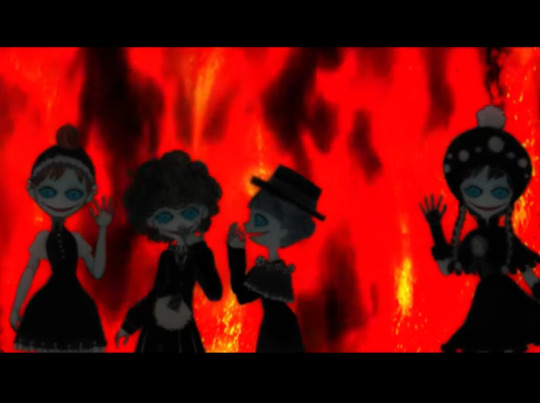
However, the so called “children of the fake city” are faking their tears and each one of them is called after a negative trait Homura is convinced to have. It is interesting that the last one called love is said to never appear. This has probably to do with Homura feeling that she does not deserve to be loved.
The red spider lily as well is a flower often associated with grief and death and a bunch of lilies appear when Homura realizes that she is a witch. Moreover these flowers can be contrasted with the white ones which appear in the field where Homura sits with Madoka:
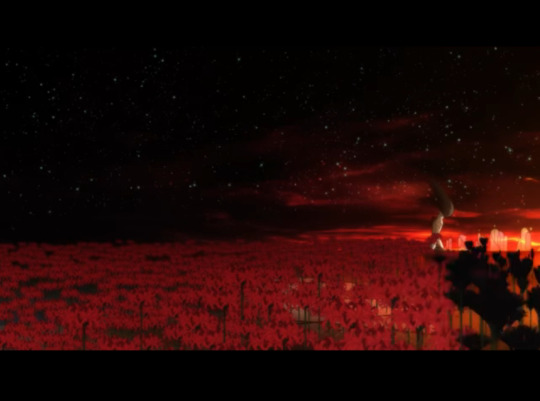

What is more, spider lilies emerge from Homulily’s skull:
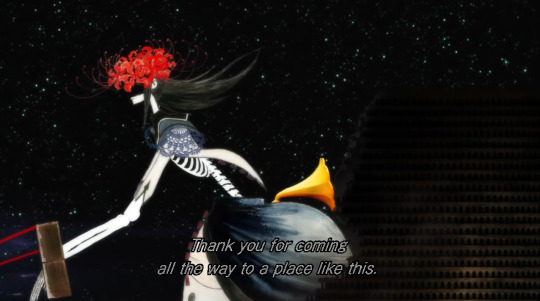
I am quoting the wiki:
A promise is the only thing that pitifully planted in that head which can no longer crack any nuts, but within the husk of the awakened witch is the distinct form of a magical girl.
The promise which was planted in that head is the vow Homura made to protect Madoka. The fact that it is such a flower the thing which symbolizes said vow is interesting because it shows once again how it is something born from Homura’s grief over her friend’s death and how with time it has become her fixation to the point that it completely took over her head.
The witch being compared to a nutcracker highlights another motif Homulily is associated with aka Nutcracker, the ballet. As the wiki says:
In the story the nutcracker was once a human who was transformed into a nut cracker and later given as a gift a Christmas party where he was damaged, the girl felt sad for him and took care of him, then when the mice attacked he came to life and defended the girl. Similarly Homura started out as a normal girl and was held back by her heart condition, then she befriended Madoka and the others and became a Magical Girl and grew stronger with the intent of protecting Madoka; which would be similar to the role reversal in the ballet. However since Madoka died in most of the timelines until she finally ended up as a part of the universe, Homura could see herself as still being the damaged nutcracker doll who can’t protect the girl who helped her or even fulfill her most basic purpose.
This interpretation is strenghtened also by the fact that some of Homulily’s servants (Luiselotte) are meant to hunt white rats like the one in the Nutcracker’s story. It is clear who Homura considers the rat in her story:
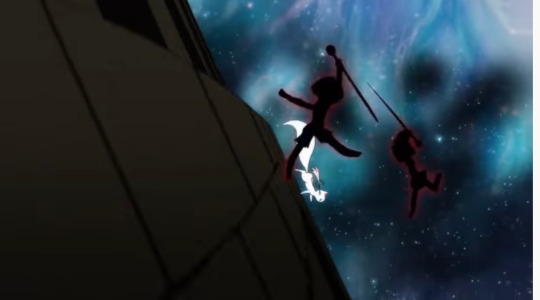
Homulily being associated with a useless nutcracker explains also the teeth associated with this witch. As a matter of fact nutcrackers are used to break nuts, so that they can be chewed easily, but since Homulily is a broken nutcracker teeth decay and fall because they try to chew what they can’t. At the same time dreaming of a broken or fallen tooth means that a relative or a loved one will die soon, so they too are symbols of death and grief. In a sense the teeth are the deaths Homura was not able to avoid because of her being useless (to be clear, I don’t think Homura is useless; this is just how she perceives herself).
Finally Homulily’s hat resembles a record which becomes broken once the witch is beheaded. The hat falls and is later splashed by Homulily’s own foot. After this happens Homulily’s cry where she thanks Madoka and apologizes to her starts in a broken voice and it is as if it is being broadcasted by the grammophone on the witch’s back.
The idea of associating Homulily to a broken record together with the witch repeating her own execution again and again is perfect to convey Homura’s story. As a matter of fact Homura kept repeating the same month in order to save Madoka, but she failed. In a sense it is as if Homulily wants to die as many time as Madoka did.
These are the main motifs and symbols associated with Homura’s witch form, but the scene you asked about has also other segments other than the ones where the witch and her servants appear.
First of all there is the one where Homura and Madoka are sitting together in a field of white flowers:

Homura sees Madoka fall and moves to stop her, but fails. While she does so she leaves her old looks behind and acquires the appearance she has in the original series. In short this segment symbolizes Homura’s development and her becoming who she is because of her attempts to chase after Madoka and to “catch” her before it is too late.
Let’s also underline that Madoka’s position resembles a crucifix and so it might be a reference to Jesus Christ which would fit given the fact that she has become a Goddess to save all magical girls. Either way, it is clear that Madoka’s fall represents her sacrifice and how Homura perceives it as Madoka slipping away and disappearing.
After she fails to catch Madoka Homura is surrounded by a group of old versions of herself who look at her with contempt:

This symbolizes once again Homura’s self hate and how in a sense she has deluded the girl she once was and who started her journey motivated by the wish to protect Madoka. In the end Homura was not able to succeed in her mission and she has grown to resent herself for this.
This is why immediately after a bigger version of herself is shown punching and destroying the whole scene in frustration:

At the same time, despite this Homura being bigger, she is far smaller than the two chairs Madoka and Homura were sitting on. This shows that how much more powerful Homura becomes doesn’t matter because she ends up feeling more and more powerless.
After this, Homulily appears and Homura describes the feeling of being a witch with all the emotions coming back to hunt her and her not being able to remember anything if not fragments of light and regret. She also comments that this is her despair and while she does this image is shown:
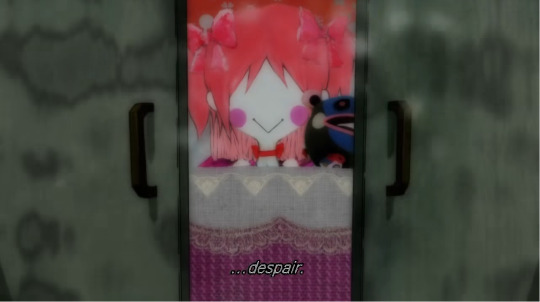
This is Homura’s wish to have Madoka in a safe place. Let’s highlight that this picture perfectly shows what Homura will do in the end aka closing Madoka in a golden cage where she is safe, but trapped (stuck in a closet) and where she can’t grow (the Madoka in the picture has childish connotations like her red ribbons and a plushie; moreover she is in a bed as if she is about to sleep).
At this point Homulily is beheaded and what I described above as the witch’s broken cry is broadcasted.
Finally the focus shifts from the witch’s pompus funeral to a small salamander who cries while saying that she is sorry she could not say goodbye to Madoka:
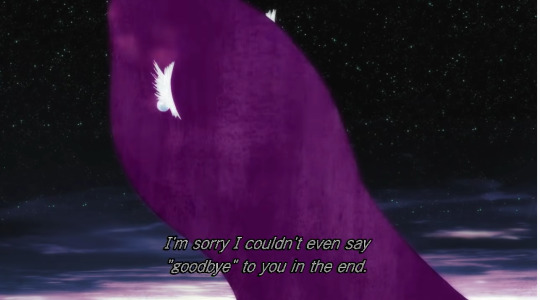
The salamander is an animal believed to be able to survive in the fire. She is associated with Homura probably because her name can be read with the kanji of flame. This little animal closes a scene which started with the labyrinth catching fire because of Homura’s feelings. In a sense, it can be considered the perfect inhabitant of such a place and a good representative of the girl who has such strong emotions.
Of course the salamander can also be seen as foreshadowing of Homura’s rebirth as a demon since the salamander like the phoenix is considered a creature who can be reborn from its ashes (and can be a symbol of Jesus Christ as well). At the same time it used to be associated with witches and Homura is currently one.
However, I think that deep down the salamander represents Homura’s strong sadness and loneliness. All she wishes is to see an important person one last time and she is far away from the ceremony organized to celebrate the witch’s execution. It is as if the scenery behind her is something of no concern for the salamander which is a stranger to her own funeral.
Thank you for the ask! I hope I was of help!
#pmmm#homura akemi#madoka meta#puella magi madoka magica#pmmm meta#puella magi madoka magica meta#asksfullofsugar#anonymous
87 notes
·
View notes
Text
A Pokemon Cosmology
Trying to have positive pokemon thoughts so I went and created a sort of map of emanations of the various mythical/legendary/ultra beast pokemon from larger concepts like Space and Time emanating down into more specific concepts like Guardians of Specific Islands
This mostly does follow canon groupings/leaderships etc but some groups were put near other groups, or in some cases given a leader or pairs associated with other pairs etc depending on if I decided I liked it or not
it’s not meant to be like “This Pokemon created this Pokemon” or etc, just that the things they have dominion over, are lesser than the things the Pokemon higher up the foodchain has dominion over
Also, sometimes some legendaries were sort of given designations that they may not have canonly have, but I think would be a good idea for them to have dominion over/represent
I made a chart and then explanations will follow:
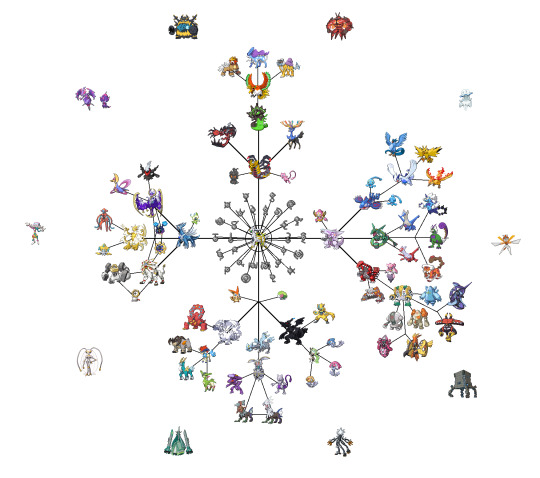
First we got Arceus, Ultimate Creator
then he’s surrounded by all the Unowns as his “Thousand Arms of Creation”
then the big three concepts he made were Dialga (Time), Palkia (Space) and Giratina (Antimatter)
First, Dialga
Since Dialga represents Time, I’d figure he’d have dominion over the Pokemon that represent the things we use to recognize Time, The Sun(Solgaleo), the Moon(Lunala) and Light/Darkness as a concept itself (Necrozma) which are all essentially concepts of Light and Energy in the Universe
Also with Dialga is Celebi, a being able to move freely throughout any Time, so possibly representing the Currents of Time, or specifically Past, Present and Future
Undereath Lunala (The Full Moon) we have Cresselia (Crescent Moon) and Darkrai (New Moon), the three of them representing the Night and possibly Dreams
Under Solgaleo (The Sun) we have Meltan(Metal) and Melmetal(Fusion), and where Lunala and friends represented things of a metaphysical nature, Solgaleo and friends represent Light’s more physical side, with Meltan and Melmetal representing the idea of a Star’s molten metal core as a representation of the byproduct of Nuclear Fusion and the natural origin of all Metal
Lastly under Zekrom (Light) are Jirachi(Meteors/Stars) and Deoxys(Auroras) the other natural phenomenons that symbolize Light other than the Sun and Moon
Then Cosmog/Cosmoem represent Nebulas/Cosmos/Shiny Stardust and put under Lunala/Solgaleo as their natural parents
Next, Palkia.
Palkia represents Physical Space, and therefore, the next in line are those that created the pieces of our Physical Planet, Kyogre (Ocean), Groudon (Land) and Rayqauza (Atmosphere)
Also with Palkia is Hoopa, a being with a relationship to Palkia similar to the one Celebi has with Dialga, being able to freely move throughout Space, teleporting as it pleases, representing the idea of Teleportation and Location.
Celebi and Hoopa are not higher than Dialga or Palkia, they merely have the total freedom to explore the ideas under their dominion, theyre like Palkia and Dialga’s kids. Manaphy had the title “Prince of the Sea” under Kyogre, maybe Celebi and Hoopa can be the Princes of Time and Space?
Under Kyogre (Ocean) we have Phione (Warm Seas) and Manaphy (Cold Seas).
then also we have Lugia (Beast of Underwater Currents) and under Lugia the three legendary birds.
Now, the three birds don’t really all have an association with some form of water, but you could stretch them into either Weather Patterns (Which are determined by the ocean and it’s currents) as Snow/Rain/Sun OR as representing different States of Water, Frozen Ice (Articuno), Liquid Rain (Zapdos) and Gaseous Vapor (Moltres), which, kinda makes sense, idk theyre ruled by the ocean currents and all live on islands surrounded by water its the best I can come up with
either works, but, since there is a “Weather Trio” later on, the states of water probably work best
Nest we have Rayquaza (Atmosphere) which has the underlings Latios (Cold Air Currents) and Latias (Warm Air Currents) and from them spawn the actual Weather Trio, Thundurus (Humidity), Tornadus (Wind) and Landorus (Heat), rather than just saying rain/storm etc I figured making it the three factors that control all the weather patterns that can happen to make the most sense here
Finally we have Groudon (Land) which has the underlings Heatran (Earth’s Molten Core) and Diancie (Earth’s Crust) and I like this because it matches the pattern of each Planet Trio member having two underlings representing the hot and cold versions of each trio. Also under Groudon (Land) we have Regigigas (Continents) who rules landmasses in general, then under Regigigas we have the various types of solid landmasses possible Regice (Ice/Snow/Tundra), Regirock (Stone/Earth/Mountain) and Registeel (Cities/Steel/Construction).
Then separately under Regigigas, but lower then the other 3 Regi’s, we have the rulers of specific small particular landmasses, various Island Guardians, the 4 Tapu’s. I’d say Regigigas is their direct ruler, because what are islands except Tiny Continents, but theyre lower in priority than the 3 Regi’s since those guys represent 3 basic types of landmasses, similar but different.
The more specific you get the more things fractal outwards
Next we have Giratina who represents Antimatter, and under him most nonphysical/spiritual concepts that are misunderstood and foreign and hard to grasp, since they sort of exist on the “other side” of things. Xerneas (Life), Yveltal (Death), Zygarde (Balance/Aura).
Also with him is Marshadow and Mew. Marshadow is a ghost pokemon that lives in the shadows, but also represents the idea of the “fighting spirit” which often associated with “Aura” in pokemon. Whereas Mew is the genetic physical origin of all living Pokemon.
So both sort of represent the two halves needed to create a living existing creature. Mew representing the body and the physical form, Marshadow representing the soul, the spirit, or the aura needed to give life to that physical form. Dunno what exact title to give, perhaps Prince of Aura and Prince of DNA or something along those lines.
Underneath Zygarde, representing Balance/Nature, we have Ho-oh representing Reincarnation or Rebirth
and while you’d think it makes sense to have Ho-oh underneath Xerneas (Life) instead, the idea of Rebirth naturally involves a delicate Balance or natural Cycle of both Life and Death. So under Zygarde they go.
then of course Ho-oh as Reincarnation has dominion over Suicune (Purifying Water), Raikou (Revitalizing Electricity) and Entei (Transmuting Fire) aka the various ways something can be “reborn”: Purified of any corruption or healing of damage, given new strength or Vitality, or physical remoulding of it’s shape or form, the same things that happened to all three. (also because i like to believe that while Unown’s may have created the Entei in the third pokemon movie, it’s ability to reshape reality at will could have naturally been it’s own as well, maybe, i know not really but still)
This has potential then for future legendary pokemon underneath Yveltal and Xerneas to represent different specific concepts of Destruction/Death/Illness and Creation/Life/Healing. Like Sickness, Old Age, Decay, Growth, Youth, and Vitality.
Next we have those also directly under Arceus, as an ultimate creator, whereas Dialga, Palkia and Giratina represented Time, Space and Antimatter respectively, Arceus has dominion over the concept of Humanity, with me sort of borrowing the concept of gods creating humanity in their image.
Now, you can see a sort of empty point here where it looks like a Pokemon should be in this spot, similar to Palkia/Giratina/Dialga, but this is because technically Arceus is both directly fulfilling this spot, and because this spot overlaps with the three beneath it, Reshiram/Zekrom and Kyurem. I kind of see it as both Arceus and “the original dragon” that is Reshiram/Zekrom/Kyurem all fused, which we get close to, but never really fully see. And i like this because it kind of highlights that the question to humanity’s existence and purpose, doesn’t have an answer, just like this spot doesn’t have a ruler.
Here also, we have the two beings who would have supported what this ultimate being of humanity might have represented, and indeed what Arceus may have intended to shape humanity into all along.
Victini, representing Power, Victory, Success and Shaymin, representing Gratitude, Appreciation, Recognition.
Really does paint a picture of an almost angelic sense of euphoria and love. If we take even more christian mythos as inspiration here, it makes sense that the lack of a figure representing Euphoria and Love as penultimate concepts of humanity, and the fact that it no longer exists, almost points to a “fall of man/why evil exists” kind of situation, where that being of love and euphoria and what it represented was rejected by those it was meant to have dominion over, and was thus shattered from existence as a result. And it makes sense in another way too, to be eternally euphoric kind of demands a lack of free will and choice in order to be true, which humanity would obviously never accept, even if temporary pain and evil was the result.
So from that, Reshiram represents the human conception of Truth, and Zekrom represents the human conception of Ideals. This is branched out to be a sort of Intellect/Rationality versus Emotion/Freewill kind of idea in my mind. But they also represent different forms of Energy, Reshiram’s Fire and Zekrom’s Electricity. Kyurem as the third is a nullifier of both, due to it’s nature as empty husk of the original. So while Reshiram/Zekrom represent the natural leftover concepts of Humanity and Energy, Kyurem represents unnatural humanity and Entropy (Absolute Zero Ice).
So from Reshiram (Truth), spawns the idea of Keldeo (Justice), the idea that things can be Right or Wrong, or can be logically determined as such. This gets you Cobalion (Rationality), Terrakion (Reality) and Virizion (Intellect).
A subset of Reshiram’s Fire Energy we also have Volcanion, who represents specifically Steam energy.
on the other side, you have Zekrom (Ideals), spawns the idea of Meloetta (Expression), the idea of individuality and that each person has their own perspective or priorities. This gets you Azelf (Willpower), Uxie (Knowledge) and Mesprit (Emotion) (also it just feels really aesthetically nice to think of Meloetta as the Lake Trio’s “leader” she has basically the same color scheme and design of being somewhat pixie like, has the fourth color green to the lake trios red/yellow/blue, and is slightly taller more humanshape to denote her status as leader, its a great idea and you should love it like i do)
a subset of Zekrom’s Electric energy we have Zeraora, who represents specifically Plasma Energy.
Underneath Kyurem (Unnatural Humanity) we get all of our man-made legendaries. Starting with Magearna (Manufacturing/Man-Making in general) as the oldest legendary created by man, then branching out to Genesect (Scientific Modification), Type:Null (Scientific Blending) and Mewtwo (Scientific Creation). Then Type:Null gets its evolution in Silvally, possibly representing the concept of Trust or Friendship as a whole, a wholly natural human activity, that also has to be created or nurtured by humanity to continue existing, Naturally Man-Made, a perfect blend of the two. And I like the coincidence that a lot of the manmade pokemon are a direct result result of man’s freewill to be evil or good, just like they were a direct result of Kyurem/Reshiram/Zekrom’s current state of being.
Lastly the Ultra beasts are kind of, outside of this whole dynamic, I’m not sure if i could solidly put any of them directly tied to Dialga/Palkia/Giratina/Arceus, like there’s some that I thing could kinda work maybe in some cases but overall not really?
Like Xurkitree Kartana and Celesteela looking very man-made (but they aren’t technically) Poipole/Naganadel representing Poison and possibly Illness or Decay, putting it under Yveltal as Death, same as Guzzlord being Destruction
But it’s not, the greatest, so overall I just kinda put them in a circle outside of everything, but closest to the major concepts they sort of have a connection with.
But instead of being tied to anything directly and representing specific concepts, they represent extremely vague ethereal/ephemeral concepts in contrast that are also very alien and inhuman and almost eldritch (when not representing specifically human concepts)
Guzzlord - Represents Destruction in all it’s forms, recycling, transformation, restructuring, but not with any malice, just with the cold unthinking unreasonable processing of a wood chipper eating your leg.
Poipole/Naganadel - represents poison, illness, sickness, decay, old age, allergies (because theyre bees) basically all things that usher in potential death
Blacephalon - represents Primal Fears/Illusions/The Void/The Ineffable/Unknowable/Eldritch due to the clown association and it’s attack Mind Blown hinting at a more “its all in your head/cannot comprehend the nature of this attack” concept as well.
Celesteela - represents all the ideas of motion, the laws of gravity, propulsion, magnetism, all the forces of the universe that push and pull things together or apart
Pheromosa - represents all concepts of value, beauty, worth, strength, ability, importance, awe, wonder, admiration, love, desire etc the things most humans desire to head towards at full speed
Xurkitree - represents all concepts of machinery, clockwork, computers, circuits, programming and automatons and technology in general, past present future and alien.
Stakataka - represents ideas of a legion, many being one but all being the same, lack of individuality, a hive mind of samey clones, moving and speaking and being in constant unison, like grains of sand, drops of water, leaves in a forest, it is indistinct, incomprehensible, numerous, countless, innumerable, incalculable, immeasurable, untold, endless etc
Kartana - represents the concept of all physical textures, rough, smooth, sharp, hardness, hairy, coarse, fluffy, slimy etc
Nililego - represents ideas of infiltration, parasitizing, possession, loss of identity, erosion of the self, influencing, puppeteering, invasion, permeation, infection, an undoing of boundaries, overlapping, linking together, echoing
Buzzwole - represents all concepts of power, strength, dominance, leeching, violence, force, ferocity, wildness, cruelty, hatred
107 notes
·
View notes
Text
An Introduction to Origami/Paper Magic Pt.1
A bit of history...
Origami is composed of the Japanese words oru (to fold) and kami (paper); it was originally known as orikata (folded shapes). This art and practice came to be after Japanese monks brought paper from China to their country in the sixth century. Because paper was handmade, it was an expensive, luxury item that was not commonly available; to add to that, the practice of paper folding was reserved for ceremonial purposes —which were, more often than not, religious in nature.
By the Edo period (1603 - 1868), thanks to paper becoming mass produced and more accessible, origami has also become a recreational activity. The first written instructions appeared in 1797 with Akisato Rito’s Sembazuru Orikata; and by the late 1800s, the term had morphed from orikata to origami.
In traditional origami, folding patterns and sequences were passed down orally or anonymously from generation to generation. Nowadays, there even exists designers that create —and even copyright— their models. Modern origami also focuses a lot more on adding a certain puzzle aspect to the models, and prioritizes the ability to create using only one sheet of paper without glue or scissors (of course, there exist ‘advanced’ models where you combine smaller, individual creations to make something even grander).
Akira Yoshizawa is considered one of the fathers of modern origami. In the 1930s he developed a system of folding patterns which employs a set of symbols, arrows and diagrams. These patterns were published by the 1950s and quickly became easily available, which contributed to making origami the widespread practice that it is today.
-> Did you know?
Europe has its own practice of folding paper. It was developed in Spain and dates back to the twelfth century, when the moors brought a tradition of mathematically based folding. It is known as papiroflexia or pajarita.
Of colors and patterns
Naturally, because we’re dealing with paper, it might come in all sorts of colors and patterns (especially if it’s origami paper, which can be usually found with all sorts of patterns on it). I can’t really cover every single pattern, —not with how comercial origami has become, but I’ll try to add some of the most basic ones you’ll probably be able to find.
For colors, I’ve borrowed @jasper-pagan-witch’s master list of correspondences. Of course you’re free to use your own correspondences!
Now let’s talk patterns. There’s a lot of possibilities for patters that you can find out there, specially after origami became something a bit more ‘commercial’. It is impossible for me to cover all of them, so I decided to compile a list of basic Japanese symbolism (since the practice is originally Japanese) that you might be able to find in paper design + basic geometrical shapes which can also be found, but do keep in mind there’s like a pattern for virtually anything out there. Once again, feel free to use your own correspondences!
The Sun: This symbol is derived from the mythological goddess of the sun, Amaterasu, from the Shinto religion. Because she founded Japan, it can be interpreted as a symbol for beginnings and for journeys, it is also considered a symbol of good fortune.
The Lotus: Purity, cleansing, enlightenment.
Folding Fan: Journeys, beginnings and ends, cycles, possibility. Also secrets, as they were used to convey secret messages in the past.
Chrysanthemum: Endurance, rejuvenation, happiness (from the National Japanese Chrysanthemum Day which is referred to as Festival of Happiness). Joy, beauty, good luck, longevity, fidelity, optimism.
Daruma: Wishes, achievements, perseverance, commitment, determination.
Sakura: Fleeting beauty, transience of life, renewal, new beginnings.
Butterfly: Metamorphosis, transformation, eternity (in close association to spirits and the afterlife, since they’re linked with recently departed spirits).
Cranes: Longevity, good fortunes. It is said that if you fold a thousand paper cranes, your wish will come true.
Plum: Refinement, purity, perseverance, hope, beauty, protection against evil and misfortune.
Gourd: Divinity, good luck, good health and prosperity.
Moon: Rejuvenation and new beginnings.
Koi: “According to the Japanese legend, if a Koi fish succeeded to swim upstream and climb the waterfalls at a point called Dragon Gate on the Yellow River, it would transform into a Dragon.” (Aung, 2015). This is the reason they’re regarded as a symbol of aspiration, perseverance, effort.
Acorn: Symbol of good luck.
Shapes: You can check this post and this post which I liked for shale correspondences.
Practical Uses
Paper-made things can actually be quite useful, since the folds make your creations very resistant. There’s a lot of things you can do to put origami to practical use, and I’m gonna list some that I’ve done myself, maybe you can think of more!
Boxes: for gifts, for storage...
Organizers: kinda similar to the above, but you can use them for like pencil holders and the like
Cellphone stands and other sorts of displays
Cute little gifts/details for your loved ones
You can even make yourself a wallet
Bookmarks!
I’ve even see people do trash cans, the possibilities are endless
Your very own friend

No but in all seriousness, there’s a lot of things you can do with origami. I personally use it a lot when it’s a special day, like Mother’s Day, to make creative and ingenious cards and decorations. There’s always something new to do.
Magical Uses
And now finally, what you were probably waiting for. Magical uses are just as varied as practical uses, and I don’t think there’s a limited way of incorporating it to your craft, but I’ll give you some examples!
Altar decorations and offerings: does your deity fancy a specific animal? I bet you can find an origami pattern to do it. A special flower? Check. Seriously, there’s a lot of things you can find patterns of. There’s also really pretty boxes and bases you can make to put things.
Meditation: for those of you who can’t lie still, folding paper while meditating might help you focus!
Spells: you can combine in sigils in this one. Just choose a paper of the pattern/color that bests serves your cause and choose an origami folding pattern that correlates and just, fold it while focusing on your intention, that’s it. You can activate/dispose of it with your preferred method but if you’re using fire do refer to @jasper-pagan-witch’s guide on handling fire.
Manifestation box
For the pro-curse folk, embed a curse in a little origami crafted by you and gift it to the person, it’ll last until they get rid of it ;)
And I’m sure there’s a lot more things you can come up with! After all, each path is different and these are just some of the things I’ve tried so far.
Thanks a lot if you’ve read until here, I hope you liked the lesson. I certainly hope to come back with a part two on how to get started on origami if you guys do end up finding this bit of magic interesting, please let me know!
May you find happiness and growth in your paths!
Sources
History of Origami / Japanese Symbolism / This very cool Masterpost / Origami Magic Ideas
13 notes
·
View notes
Text
PROBABILITY DISTORTION - Or why Jaime Lannister is less likely to die than you think (part 2)
Most of the popular clues hinting at Jaime’s potential death, come in the form of foreshadowing. There are three hints in particular that are always brought up, in no particular order: “Born together/die together”, the weirwood dream, and “in the arms of the woman I love”. Let’s look at each one of these.
Born together, die together
Jaime (ASOS): “I cannot die while Cersei lives. We will die together as we were born together.”
Cersei (AFFC): “We will leave this world together, as we once came into it.”
This is seen by many as proof that the twins will die together (and is the origin of the “valonqar corollary”, where Jaime is the valonqar and will therefore kill himself after, even though no such thing is mentioned in the prophecy). But in 2011, GRRM had this to say about it:
“There’s an element of sociopathy to it, where it’s the two of us and no one else really counts, especially outside their family. They’re twins, they were born together, they have a feeling that they’re going to die together. There’s this bonding that they’re two halves of a whole, so who else would they pair with? Anything else is lesser.��� (GRRM)
There’s a lot to unpack in his statement, but I want to focus on two things: “they have a feeling that they’re going to die together” and “they’re two halves of a whole, so who else would they pair with? Anything else is lesser.”
GRRM is careful to specify that that’s a feeling they have, it’s not a truth. He might obviously be avoiding spoilers, but I think there’s more to it than that, in the sense that he is using that belief of theirs as an example of the level of unhealthy obsession and delusion in their relationship. This is the point at which their story begins; the point at which they buy into this notion that they’re two halves of a whole and the only ones who matter. I already discussed in part 1 about narrative arcs, how perhaps the main part of Jaime and Cersei’s story is about discovering that they’re not two halves of a whole, and set off on opposite journeys. Indeed, Jaime’s quote comes from early on in his POV, before he returns to King’s Landing and his disillusion with Cersei begins to set in. And GRRM is indeed raising a question that will be addressed later, as their story unfolds: “who else would they pair with?”. Of course, at the beginning of their story, the answer is nobody because “anything else is lesser”, but will that still be the answer in the future? (6’3” hint - probably not).
As the story progresses, the two become disenchanted with the other, with some symbolism thrown in for good measure (such as Jaime losing the hand he was born holding Cersei’s foot with, or the wind in his hair being compared to a generic woman’s fingers, instead of Cersei’s like pre-rift), until Jaime burns the letter Cersei sent to ask him to be her champion in her trial by combat; i.e. win for her or die with her (see this Reddit post for a nice comparison between Jaime and Cersei’s belief they will die together).
With that gesture, Jaime essentially refuses to go die with her and abandons her to her own fate, therefore rejecting the belief they must die together (he later even thinks that he “guesses he might have to face her, if she’s not dead already”). In 2014, when asked about how he was planning to deal with them in the future, GRRM said:
“Well, as for the books, I have two more to write. I’m certainly going to be dealing with Jaime. Jaime and Cersei’s relationship is in a very different place in the books than the show has reached now. They are effectively estranged now.” GRRM sees this moment as their estrangement.” (GRRM)
Note how back then George said just how far Jaime and Cersei’s relationship had “reached” in the show, compared to the books, implying the show still needs to get there. Fast-forward to 2017, and the final thread of tv!Jaime and Cersei’s relationship snaps as well. Jaime heads north to fight for the living, leaving her to her own fate in King’s Landing, a snowflake melting on his glove in the same way it melts in the books, signaling the arrival of winter (it’s also interesting that the show has omitted these lines, changing them instead for “We were born together, we belong together”).
Could their “feeling” that they will die together turn out to be true regardless of their journey, even if it means dying at the same time, miles away from the other? Maybe. But foreshadowing often exist to foreshadow the *opposite* of what is stated, and this is especially true when it comes to a character’s own beliefs. This is another important feature of the POV structure. Characters can be unreliable narrators, telling us about feelings they’re still confused about, which are not clear to them, or convinced of things that are not true. The most glaring example of unreliable narrator, without straying too far into other POV’s, is Cersei herself. For example, in ADWD, when she’s confronted with the fact that Jaime has gone MIA in the Riverlands with Brienne, Cersei’s reaction is to dismiss the news as impossible:
“Jaime would never abandon me for such a creature. My raven never reached him, elsewise he would have come”.
But we, as readers, know that Jaime did receive her letter, burned it and set off with Brienne. Cersei is wrong in her beliefs. This type of unreliable narration can also be at play with regards to beliefs the characters have about their future, such as Jaime bitterly thinking he is “a warrior, and that’s all he’ll ever be” (err, no; we know GRRM does not have that planned for him), or when he thinks about how much he’d rather be dead than a cripple (and then he gets his hand chopped off and has to live with it).
Given their journey, and the way their bond is, in many ways severed, as things stand, and that those quotes reflect a feeling Jaime and Cersei have at the stage of their relationship where their delusion and obsession was strong, I think it’s very possible this is one of those hints that foreshadows the opposite turn of events.
The weirwood dream (a.k.a. “I dreamed of you”)
"The flames will burn so long as you live," he heard Cersei call. "When they die, so must you."
[…] The fires that ran along the blade were guttering out, and Jaime remembered what Cersei had said. No. Terror closed a hand about his throat. Then his sword went dark, and only Brienne's burned, as the ghosts came rushing in.
"No," he said, "no, no, no. Nooooooooo!"
The weirwood dream is another fan favorite when it comes to predicting Jaime’s death. I once wrote a long post analysing this dream, and I might rewrite one for the blog, but I’ll try to stick to the basics here. The dream is clearly prophetic since many of the things in it do actually happen later on, and the fact that Jaime has it as he sleeps resting against a weirwood stump suggests there might be some magical intervention at work. Many think that this foreshadows Jaime dying in battle against the Army of the Dead, since Jaime and Brienne here are facing dead people “armoured in snow”. But I think there’s much more at work here. What I think George might be doing is to deliberately get people, throughout the early part of the dream, to focus repeatedly on the association between light = life and lack of light = death, so that when Jaime's sword dies out, the reader's brain is primed to think "He's dying". In many ways, this is no different than those tricks where you ask someone to repeat "fork" fifteen times and then ask them "what do you eat soup with?" and they say "fork".
But a key aspect of the dream is the thing that constantly gets ignored: Brienne’s presence. Brienne is standing by Jaime’s side, wielding her own flaming sword and repeating “I swore an oath to keep you safe”. Once Jaime's light goes out, hers is still burning (and Jaime at that point is still alive: he’s screaming “No” over and over).
When you think about the fact that protection (and fear of failure at that) is one of the biggest themes in Brienne’s arc, and the many lines and dreams in books and show that seem to draw a connection between Brienne and protecting Jaime from death (“Who wants to die defending a Lannister?”, “You can’t die. You need to live.” , “she saw that the dying king was not Renly after all but Jaime Lannister, and she had failed him”, “Nothing is more hateful than failing to protect the one you love”), the fact that she’s meant to be his protector is a relative no-brainer. Jaime even tells Qyburn as much, earlier in the books. And I think her presence in the dream represents just that. Cersei talks about the flames in the plural sense. There is no explicit, direct connection between one specific flame and one specific life, nothing to suggest that Brienne's flame isn't enough to keep both of them alive. And the dream is a reminder that Brienne would do everything in her power to protect Jaime.
Brienne: "Ser Jaime? I am grateful, but . . . you were well away. Why come back?"
Jaime: "I dreamed of you."
The dream, in the books, is what spurs Jaime into going back to Harennhall and save Brienne from the bear (who is foreshadowed in the dream itself). Why would a prophetic dream, most likely due to magic, where Brienne is defending him from ghosts with her flaming sword, be the catalyst for Jaime to run back to Harrenhall and save Brienne’s life? My money is on the fact that it’s because it foreshadows Brienne protecting him from death when they’ll end up facing the Army of the Dead in the future, with their twin swords. Had Jaime had not gone back to get her from that bearpit, she would have died, he will have nobody to protect him and die himself. Why exactly the magical intervention was needed to keep them alive, remains to be seen (someone should ask Bran, I think he might have a hand in this).
We don’t have the dream in the show, but the show has used Olenna in a similar way. If the weirwood dream suggests that if Jaime doesn’t go save Brienne, he will be fucked in the future because she’s going to be the only light that protects him after his family has abandoned him, Olenna’s line in the show is the mirror image of the weirwood dream, suggesting to Jaime that if he doesn’t leave Cersei, she will be the end of him. And, at the end of S7, he chooses to do the right thing, live her and fight for the leaving.
In the arms of the woman I love
Bronn: “How do you want to go?”
Jaime: “In the arms of the woman I love.”
Lately, this S5 conversation between Bronn and Jaime is the greatest hit of foreshadowing. You’ll find it literally everywhere, from Reddit to Twitter to YouTube. Debates continue over whether the woman in question will be Cersei or Brienne (some suggest it’s Brienne, because Brienne held Renly in her arms as he died - re-read part 1 about Brienne’s arc to see what I think of that), but the general consensus is that this is foreshadowing that he will die. Like with any line that is taken as foreshadowing, we can’t know for sure until the end, but I argue that people might be missing the forest for the trees in this case. I think the debate over which woman it might be is much more important than that line itself. Indeed, people always ignore the last line of that dialogue:
Bronn: “Does she want the same thing?”
This stumps Jaime and ends the scene, leaving the audience with all sorts of questions: is he stumped because he’s thinking about whether Cersei would want that? Or because he’s thinking about whether the woman he loves now is still Cersei or Brienne (it’s no coincidence this is the same episode where shortly before this scene they inserted a totally gratuitous scene of Jaime gazing longingly at Tarth)? Or because he is thinking about how the answer might change depending on the woman? Or because he’s thinking whether they would want to die in his arms? We are meant to make our own assumptions as to what goes on in Jaime’s mind at this moment - Nikolaj himself said as much in a tweet to a fan asking him whether Jaime was thinking of Brienne or Cersei. That, I would argue, is the whole point of the scene. To stump the audience just as much as Jaime and raise these questions.
Furthermore, even if it is foreshadowing his death, it doesn’t specify anything about the circumstances. It could be in battle (which I have already discussed the likelihood of), it could be murder at Cersei’s hands to fulfill their “born together/die together” foreshadowing (which I have already discussed the likelihood of), or it could be as an old man in his castle (which, interestingly, is what Bronn suggests - albeit in his usual crass way).
And since we are in Bronn’s company, I want to bring up another exchange the two have in S7 that is almost never mentioned in terms of foreshadowing. Right after Bronn saves Jaime from being roasted by Drogon, he says:
“Until I get my castle, nobody gets to kill you. You don’t get to kill you. Only I get to kill you.”
Which suggests that, unless Bronn suddenly sells out to the other side and assassinates Jaime (which is unlikely, given that I doubt a main POV character like Jaime is going end his story being betrayed and assassinated by a minor character he barely interacts with in the books), and for as long as Bronn is alive, Jaime just found himself another protector.
So, in conclusion, yes. If we analyse narrative arcs, foreshadowing and GRRM’s style (see part 3), foreshadowing is where we find the strongest case for Jaime’s death, out of the three. However, even then, the case isn’t THAT strong, when you dig deeper into the text and take into account how the foreshadowing fits or contradicts the overall arcs and themes we find in Jaime’s story and that of his two ladies.
Up next in part 3, a look at GRRM’s writing style.
#jaime lannister#jaime lannister meta#game of thrones meta#asoiaf meta#asoiaf#game of thrones#my meta#essay
74 notes
·
View notes
Note
If you didn't read the last chapter of Tsurune don't read the ask: OMG! I almost get killed in this "Masa-san lightly pinched Minato’s cheeks and pulled them" and in the car scene.I laughed so hard on minato he's really didn't think about hiding his feeling lol. what do you think about the chapter?
Took me almost two full days to reply to this, and if that doesn’t speak volumes about how wild this chapter was, then I don’t know what would.
I’d read spoilers of volume 2 right after it came out so I already knew what was gonna go down, and being very honest, the cheek pinching was something I’d actually expected to see at some point after reading the summaries of volume 1. And rather than wishing for it, I was waiting for it because it seemed so obvious to me that this was gonna happen one way or another. I mean, it’s just so much like Masaki to do something of that sort, lmao. But I admit I expected it to happen in a daily-situation scene and not… like this. As always, Ayano surpassed my expectations on the unapologetically huge amounts of gay.
I’ve mentioned this topic in my post about the differences between the novel and the anime. Minato may keep a lot of secrets from everyone, yet Masaki has been the sole exception to this ever since they met. I mean, look at volume 1. It’s basically Minato hiding nearly every important thing from literally everybody except his conveniently-there-by-narrative-default master. Volume 2′s chapter 3 is basically a massive meme based off this plot device, like:Shuu: *touches Masaki*Minato: Sir, that’s my emotional support coach.Anyway, my point is that Minato doesn’t hide anything from Masaki, ever. Not even the most embarrassing shit.
The chapter was very interesting. It was rather entretaining to see how inept Eisuke actually is regarding himself. The novel often references Amanojaku, so I was wondering if we’d ever get an Amanojaku-ish character, and sure enough, here he is.
Other than that, good God. Minato is such a fucking embarrassment. I adore this walking fivehead so much. Had to put the extent of my love for him and this chapter under a cut because it’s probably the lenghtiest ask response I’ve ever written.
I think I can’t even pinpoint what the best thing about this chapter was. Like, the details are very subtly placed in all the right spots as always, and this is probably what leaves the bigger impressions on me. And by “details” I mean the subtext and symbolisms.
For starters, Ayano knows very well how to fuck with plant language nerds. She’s used a lot of it with Masaki and Minato, and it feels like the bar just keeps going up. First it was oaks (strength and knowledge), then bamboo (inspiration), then azaleas (developing passion), and now it’s freaking bellflowers. What’s more: the ones that Minato stopped by were spotted bellflowers. They’re known for their heart-shaped foliage. In flower language, bellflowers stand for gratitude and unwavering love. And sure enough, Minato doesn’t waver at all before going into that bakery and buying a batch of cinnamon buns (did it really have to be that of all things, omg) for Masaki, specifically.
I can’t stress how wholly, completely, utterly unnecessary that was. There’s no heterosexual explanation to it. I mean, there’s no heterosexual explanation to a lot of things about these two, but the romantic connotation was really heavy on this one. You have to use a fucking magnifier to find the platonic in this bullshit, and it’s still hella hard to ignore the implications. It’s even harder when Minato is berating himself for buying the buns on impulse when he heard that they go well with coffee and thinking about how irritated he feels when Shuu is around Masaki. He doesn’t even try to pretend that he’s not jealous. Be more like any other oblivious sports anime protagonist and let me die in peace, for fuck’s sake.
I’m just trying to pretend that I don’t know cinnamon is associated with romantic love and often used to inflame passion, because that’s too fucking much.
On other news, I’m highly pleased that we get SeiKai hints even when Seiya and Kaito don’t show up together. Kaito mentioning Seiya’s name every two or three sentences and approaching Minato simply because he saw Kuma and thought that maybe Seiya was there was gold, tbh. It was a good break before the mattress fire that happens right after.
The way Minato found out that Masaki meant well and didn’t want him to become like he was in the past was just so priceless. Take this shit straight to the face, son. Get fucking wrecked by how much he cares about you.
It’s also really freaking hilarious to me how everything that concerns Minato’s relationship with Masaki involves shoujo manga tropes. Envious of your rightful rival being too long around your master? Check. Learning the hard way that it was all for your sake? Check. Getting frustrated and shouting like a bitch at the irony of it? Check.
Minato is Minato, though, so of course he acknowledges that he wants Masaki by his side in spite of this. Did he have to do that while lying in bed, though? I think the fuck not.
And cue Masaki texting him immediately while he’s doing that, because Masaki always shows up when he wants to see him, and because this has turned into a romantic comedy, apparently? Love me that age-old cliché where the main character goes to the window after getting a message and finds the person who’d been occupying their thoughts standing there by sheer unadulterated coincidence, and they fucking heard you, you little shit.
This comes in a set with the “first visit and you’re already inviting him to his room” trope because why not follow all the way down with the romcom narration structure since we’re already at it? Double entendrees every three phrases or so because go big or go home.
“Dad isn’t home yet, so should we go upstairs?”
Yeah, lmao, that’s what about every shoujo heroine says before getting lectured on how they “shouldn’t make that sort of invitation to a guy”.
“It feels great. Thank you, Masa-san.”
It doesn’t feel so great not being able to overlook this, Ayano.
“Well, I may not look it, but I am your master after all.”
SHUT THE FUCK UP, JESUS CHRIST.
Seriously, this shit only loses to Fifty Shades of Takehaya and his more than unasked-for lines about “punishing” and “thoroughly training” Kaito. Sure, none of this is on the level of dirty jokes, but the subtleties are still too many.
The fluff is what gets you good, though. Because that was fluff right there. No, it doesn’t classify as hurt/comfort. These bastards fluffy. I just wanna know who managed to stay upright after reading about Minato feeling his heart ache because it had been too long since the last time he’d seen Masaki smile at him, ‘cause I sure as fuck didn’t.
No time is wasted before they off their asses to the place where they first met, which is basically a world of their own at nighttime (it’s named Yata Shrine for a reason; fuck that reason). And of course there had to be your usual load of elusive language in the middle, where the destination is pitch-dark but the road there is all wildlife and stars and this sparkly wave of light at the end of the tunnel. Welcome to the land of bitch, this isn’t a shoujo, stop acting like one.
Or don’t. We’re indulging. Screaming internally the entire time, but still indulging.
The dialogue is so obviously crafted to seem like something else that it’s useless to pretend it wasn’t inentional. I already knew what was coming but reading about the whole thing was an experience.
“I’m happy that you became my coach at Kazemai but I’m also not, because I don’t get to keep you for myself.”
Did he have to say it like that? Abso-fucking-lutely not. But he did anyway, because since when does Narumiya Minato give a flying fuck about ambiguity versus precision?
Six kinds of gay here. And all of them confirm that Minato’s “mixed feelings” when seeing Kaito being so familiar with Masaki from the get-go were, in fact, pure jealousy. It’s not even envy, because that’s wanting something someone has and you don’t. Minato was even closer to Masaki than Kaito was at that point, so it was all just his Masaki-exclusive greed speaking, plain and simple.
This is what gets me about this scene, tbh. It’s so much like Minato to say that, but it’s so alien to read it in a shounen novel. I don’t recall seeing anything so direct and raw in any sports franchise aside from Yuri on Ice. The most we get is “I wanna do [insert sport here] with you”. But this case is a blatant “we’d be doing the thing we like together one way or another and I’d have preferred if no one else were involved”.
And this comes right before we get a reminder that Minato doesn’t like it when Masaki treats him as a child, again. That’s… something. I hate this something a lot.
Also, it feels like the two of them are having completely different conversations with each other. Masaki is talking about his struggle coaching Minato and pointing out the crap he has to deal with in having a student whose last words are probably gonna be something stupid like “oops” or “oh, shit”, and Minato is countering with apparently completely unrelated arguments.
“But didn’t you let Shuu touch your belly, Masa-san?”
The fuck does that have to do with anything? How is that of any relevance to the conversation? What is this gay nonsense?
“If anyone else heard only that, I’d sound like a pervert, wouldn’t I? Did you want to touch it too, Minato?”
JUST DISMISS IT, YOU MOTHERFUCKER. DON’T ENCOURAGE HIS FOLLY. LET IT DIE.
“I’m no pervert, so I’m good.”
And now the moment of crushing honesty is over. Time for lies and derision because we all saw earlier in this chapter that (I can’t believe I’m actually writing this) Minato did, in fact, want to touch Masaki. Boy just called himself a pervert, indirectly. Gotta congratulate him for playing himself for, like, the hundredth time, I guess.
Of course Masaki would get emo in this scene sooner or later, because the fact that he’s dealing with the most reckless character out of the cast is apparently not a pertinent reason for things to have ended up the way they did. And of course Minato was gonna do something about it. It’s almost obligatory by now that they lift each other up.
WHY LIKE THIS, THOUGH?
Like, there’s just too much here that doesn’t translate into a master-student thing. Okay, I can totally see that in the dialogue but the actions are screaming something else entirely. Obviously, as I always say, I’m not gonna label it as romantic. What I’m talking about is: this isn’t the behavior of someone interacting with a teacher, but of a person with another. I mean, no matter how you look at it, there would have been a lot to consider here regarding the minimum of restraint that one should have around their mentor or at least around their elders, but Minato is basically saying “fuck you” to all of this.
Yeah, sure, go reach out to grab his hand and gently brush his bangs off his eyes simply because you can’t help the urge to look into them. No big deal. It’s just the affection of a disciple. Anyone else would have done the exact same.
I JUST WANNA TALK, AYANO. I JUST WANNA TALK.
Not trying to stereotype or devalue the worth of teacher-student relationships. Just back to my previous point: you don’t do this shit to a teacher, realistically speaking. And even if anyone hypothetically had any gall to do that, neither the teacher nor any onlooker would disconsider it an advance. Anybody would find it a little bit out of place at the very, very least.
Also, that declaration? Literally Minato swearing he would have Masaki be the one teaching him for the rest of his life? This after having said similar bullshit like claiming that he would never let Masaki go or that he’d follow Masaki to the grave. The bar just keeps going up. So, in short, “you don’t have to be my master but I’ll be damned if you’re not my master forever”.
Ayano, you’re murdering us. You’re murdering your readers.
“I feel more relaxed when I talk to you, Masa-san.”
No news here but thank you for saying it anyway. There had to be icing on this cake. And the cherry on top was Masaki’s explanation about the word “talking”. Are you telling us that these idiots hand their hearts over to each other every time they open up like this, Ayano? IS THAT WHAT YOU’RE FUCKING SAYING, AYANO?
Love me all of Minato’s non-existent heterosexuality being killed with fire.
I imagine that Minato must have made the cutest face when seeing Fuu again. Fuu, the owl with a heart-shaped face, showing up at the most convenient time. Because heart-shaped leaves weren’t enough, apparently.
The end of this chapter made me feel a tiny bit bad for Shuu, though, because it was one more instance of something that he and Minato and no one else had in common that got overwritten and outshone. It’s definitely a parallel to when they were little kids learning under Saionji and hiding it from everyone until a certain point, yelling at the top of their lungs and being competitive while taking things seriously to an extent. Here, we have Minato and Masaki in perfect sync, reproducing the exact same thing that Shuu and Minato had learned so many years ago but with experient successfulness and also complete harmony. And this time, it’s 100% their secret only, taking place at night without the knowledge of anybody, with no audience, no parents and no teacher.
It’s… too much, lmao. In every sense. Shuu literally stands no fucking chance next to Masaki and I love it. *broadcast lady voice* Fujiwara Shuu. Repeating; Fujiwara Shuu. Your wife Senichi is waiting for you at Kirisaki High.
And of course, the chapter had to be closed with a finishing blow. God fucking dammit. Minato packing coffee to share with Masaki would have been enough, but nay, Masaki also had to bring the fucking oyaki. From the fact that they’ve had oyaki together before at the shrine and that these oyaki are from the bakery where Minato had bought the cinnamon rolls without a second thought, it’s sort of really obvious that Masaki bought them to eat together with him.
I didn’t ask for any of this and now I need to lie the fuck down.
50 notes
·
View notes
Text
5x03: Humbug’s Gulch
Hi everyone! I’m just gonna dive right in today. ***As always, spoilers abound in this post for FTWD 5x03. Don’t read until you’ve watched! You’ve been warned!***
This episode of FTWD (5x03: Humbug’s Gulch) was awesome! I loved watching it because there were so many important symbols and set ups. I'm loving where this is going.
So, we start with our group traveling around, trying to take down all of the Red Rover walkers and marking where they are on a map. As they mark them, they realize that it's a perimeter of walkers tied up around an area of land in the center. They have no idea what's inside the perimeter of walkers. So, kind of an intriguing mystery.
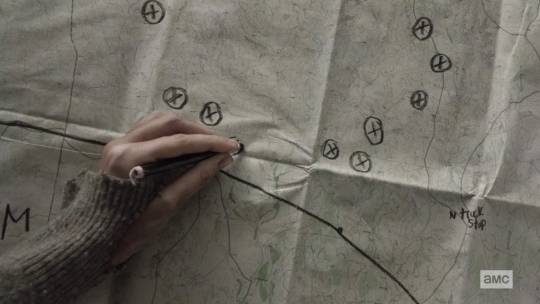
One of the first symbols that caught my attention was that when they mark the locations of the walkers on the map, use Xs inside of circles. (X Theory.) It would only be that, if it had only been Xs. But they drew an X within a circle. Remember, we saw this exact symbol around Morgan on a tree in Coda. What that tells me is that
1) whatever's going on in the season, we can connect it to Coda. That's number one. And
2) whatever they’re planning for Morgan in the season has been planned since Coda and S5. That's awesome.
Also, remember the X within the circle is sort of a skewed version of the coda symbol. A coda is more of a T, straight up and down over circle, but the X is like a version of it that’s been turned on its side.
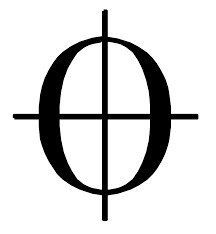
This episode is called Humbug Gulch.

It’s the name of the Western town they go to, which I’ll talk about more in a minute. But I looked up the meaning of gulch. It can be a V-shaped valley formed by erosion. It may be a small stream or dry creek bed and is usually larger in size than a gully. It just reminded me of the dry riverbed in 5x10, Them. If you keep looking at the definition, it means different things in different places, but is often associated with water. The actual definition of humbug is deception or something that's not true. Which is why Ebenezer Scrooge always said, “Bah, humbug.” It's his way of saying something is ridiculous or that's untrue. And of course, the most famous pop culture reference of the word humbug IS Ebenezer Scrooge saying it. Which makes it a Christmas reference as well. So, we have a reference to Christmas, and something that has to do with water and something we saw in Them.
In terms of the show, the phrase would literally mean ‘deceptive gulch.’ Something about this town they went to is deceptive. The meaning of the title, other than the fact that they went to a place called Humbug Gulch, wasn't obvious. But I’ll come back to this.
They mentioned a gas station when the group talked to each other over the walkie-talkies. John also mentioned their luck turning (Luck Theory). We saw a windmill at the Gulch, much like the one on Herschel's farm in S2. In most been a common symbol since then, and we usually see it in conjunction with Beth symbolism.
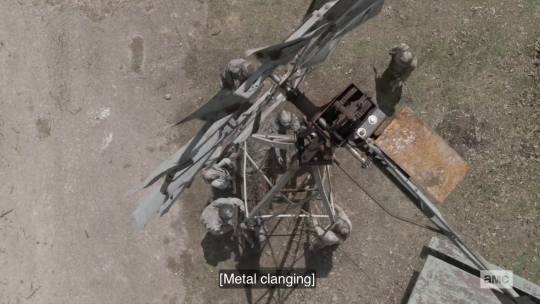
The intro was kind of interesting. It basically just showed a wind storm and a rolling tumbleweed. I wasn't sure what that meant. But as we get into the episode, John and June do have to wait at a windstorm. So, the reason for that became obvious as the episode progressed. Then we heard just a snippet of a voice on the radio. There was a lot of radio talk in this episode, and what happened at the end had a lot to do with speaking over the radio. When I heard that in the intro, it reminded me a lot of the phantom voice we heard at the end of TWD 9x16. I don't know for supposed to be connecting those, but I couldn't help but hear similarity there.
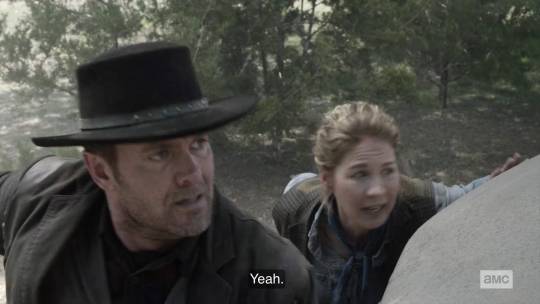
So, we had a heavy similarity here to 6X16. While attempting to take down one of the rows of Red Rover walkers, someone starts firing on John and June. They jump into their car and run for it. They ended up going to a little Western town called Humbug Gulch. This is one of those Western tourist attractions. Apparently, John used to work at one—not this specific one, but another one in a different city—so he knew what it was. Even though it was a tourist place, he knew they’d find real guns there.
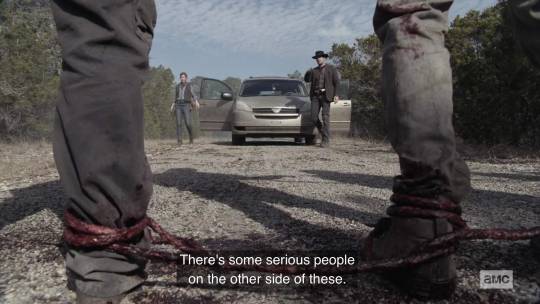
I totally didn't register this on my first watch, but when the re-watch came on, I heard it, and my mouth dropped open. Right before he being shot at, John remarks that there must be some “serious people” behind these this perimeter walkers. June then says, "We’re serious people too." When they jump in the car, John says his line again about these being serious people. Obviously a Sirius/Dog Star reference, and it’s repeated three different times.
I’ll jump forward to mention that we saw Dwight in this episode. At this point we can't prove the Sirius reference isn’t about Dwight and Sherry, but I don't think the two of them necessarily qualify. They didn’t go out of their way to make the audience think either one was dead. In fact, they kind of went out of their way to set up this story of Dwight searching for Sherry, which suggests the opposite. I'm really hoping this means is that something about this arc will lead to the original character associated with Sirius symbolism. (Beth).
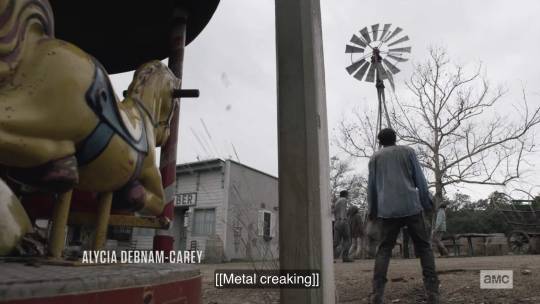
They get to the town, and we see some more interesting resurrection symbols. There’s a carousel with bright yellow horses with blue saddles that the camera focuses on for a minute. There’s also a light colored horse statue. (Looks like a palomino.) So, horse theory. And the light colored horse represents Beth and resurrection (“You’re still alive.”)
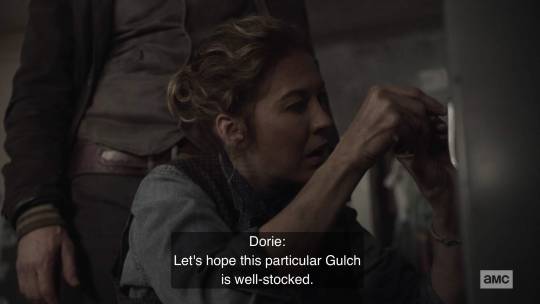
John leads them upstairs to a gun locker. June picks the lock. Inside, they find guns and ammunition. @wdway noticed little tins, two green and three yellow (both Beth colors) inside of it. Even more exciting, we see ammunition for .45 colt. Remember that issue 45 of the CBs is the one where Andrea is resurrected from the dead.
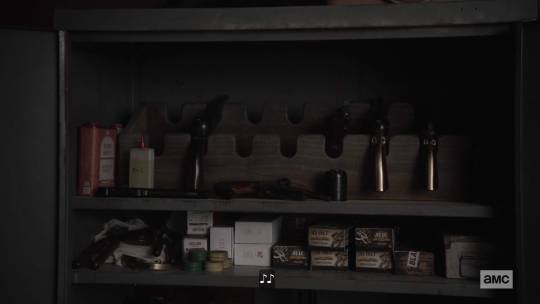
We also saw an “Exit” sign over the door, which reminded us of the one in Beth’s cell in 4x01. And the bag June carries out of the building has a B on it. Just saying. ;D
They had all kinds of fun with their Western themes in this episode. It was a really obvious old West/Outlaw/Sheriff kind of situation. So that alone is significant. John and June get the guns, but a windstorm picks up. June wants to wait it out, but John doesn't. He wants to make a run for their van and try to get back to the group. We thought John's bandanna looked an awful lot like Daryl's black bandanna from season four. An interesting callback, given all the other symbols.
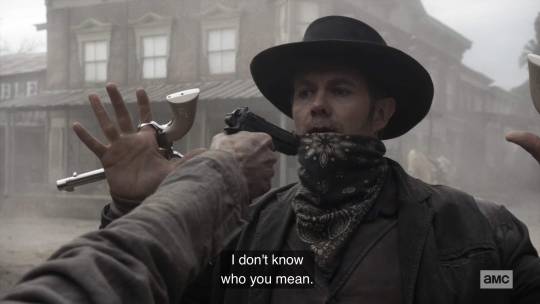
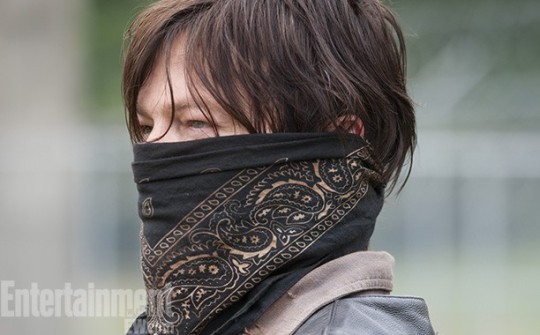
When they make a run for the car, the phantom shooter starts firing at them again. John eventually comes face-to-face with him and June hits him over the head. Guess who? Dwight.
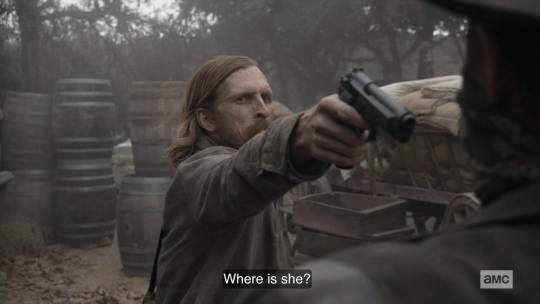
We've known we’d see Dwight this season, but I was still excited to see him. His first question to John is, "Where is she?" Naturally, John has no idea who he's asking about, but we, the viewers do. We know he's looking for Sherry.
Random detail, but I have to say I think it's adorable that John calls June, “June Bug.”
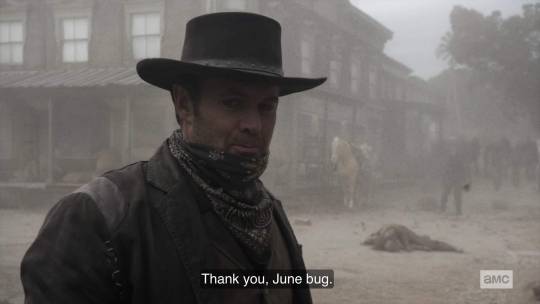
As I said, we saw something of a replay of 6x06, Always Accountable (major Beth symbolism episode). We had John and June doing their own thing, and then phantom people started shooting at them. That's exactly what happened to Daryl, Sasha, and Abraham at the beginning of 6x06. They were returning from Operation Lead the Walkers Away, and were fired on by unseen people. In that case, it was the saviors who fired at them, looking for Dwight. Then, in the same episode just a little while later, Daryl met Dwight. Here, it was Dwight (previously a Savior) who fired on John and June. Only a few minutes later, in the same episode, they met Dwight. Don’t tell me episode parallels aren’t a thing, y’all. ;D
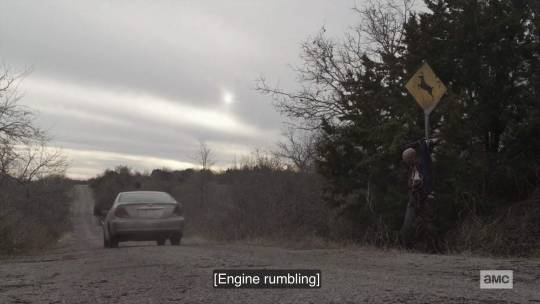
In the next scene, we see a deer crossing sign. Yet another indication of possibly someone coming back from the dead. Again, this COULD be a Sherry and Dwight thing, but I’m not convinced of that. Unlike with Glenn, Rick, and Beth, they haven't gone out of their way to make us think either Sherry or Dwight died. They merely disappeared from TWD. Also, keep in mind that this wasn't an actual deer that we saw get shot. It was a deer crossing sign. It may not represent an actual resurrection, not like the deer we saw around Rick in 5x12. But it's a symbol of the resurrection arc. I'm interpreting it as something about Dwight in this arc leading to a resurrection.
Another call back to 6x06 comes when Dwight wakes up. He basically has the same conversation with John and June that he had with Daryl in 6x06, protesting that he held the gun to their heads and he didn't understand why they would help them after that.
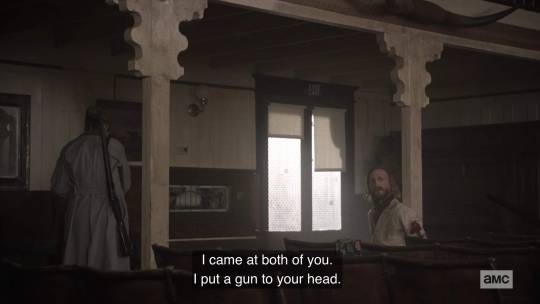
He said that same thing to Daryl in 6x06, about how he tied Daryl up and put a gun to his head and kept prisoner overnight, yet Daryl still came back to help them. Lots of callbacks to a Bethyl-heavy episode.
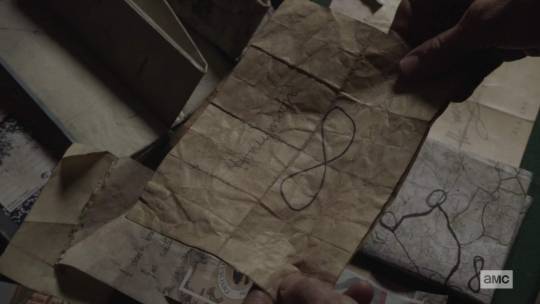
We also see lots of infinity symbols here because of Sherry’s notes. And granted, we saw them between Dwight and Sherry before, so it’s nothing new. But still interesting, all things considered.
I also think it's interesting the way they set this up. Because John looked for June (they are also Bethyl proxies) John completely understands the lengths Dwight will go to to find Sherry. He's probably the one person in the world who would have given Dwight a break over this and even helped him find Sherry. I’m just saying the crossing of Dwight’s and John/June’s stories required a lot of planning and has probably been in the works for some time. I’m positive when the writers wrote John and June’s story for last season, they already knew the two of them would cross paths with Dwight/Sherry.
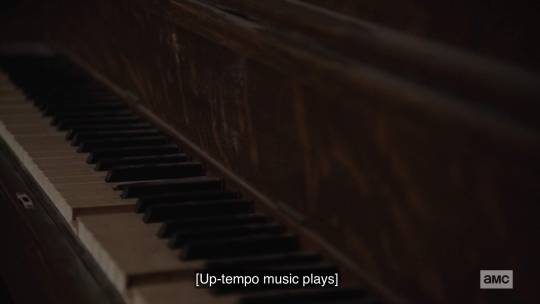
We noticed John and June played piano music to distract the walkers so they could escape. Not only a musical reference, but we can tie it to 4x01, in which they used music to lure the walkers way from the Big Spot. And of course Beth specifically played the piano in 4x13, Alone.
Rather than escaping to his car with June and John, Dwight ran to their van, which by then he'd shot the tires out of. They talk to him on the walkie and he finally admits that Sherry has left messages for him as she travels. The last one he found was written on the registration for a van that looks exactly like the one John and June were driving. That's why he opened fire on them in the first place. He thought that was the car Sherry one drove, which was why she left a note for him on the registration.
Okay, this gets super-interesting at this point. Look at this scene with Dwight in the van. Remind you of anything?
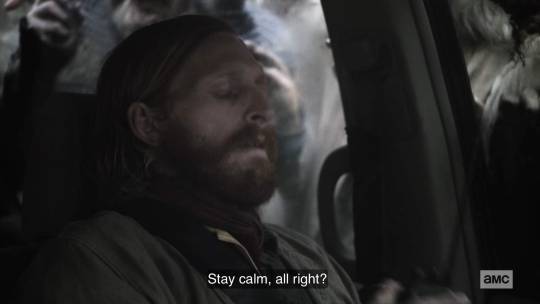
It looks exactly like the scene where Aaron and Daryl got caught in the wolf van in 5x16.
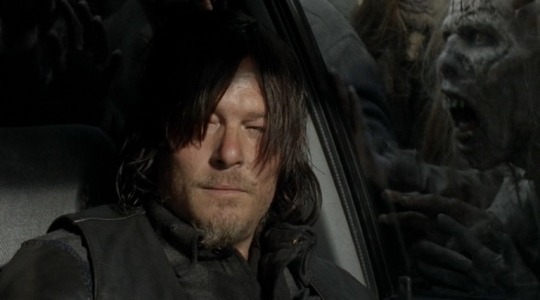
Walkers all around trying to get in, him trapped with no way out, and then Dwight has a moment where he more or less gives up.
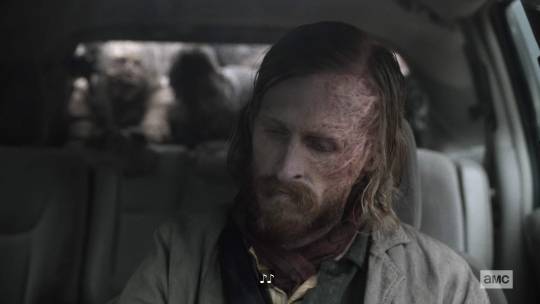
He basically tells John to go on without him, giving up both on the idea of getting out alive, and on his search for Sherry. This is a combination of a couple of things. We could compare it to Daryl in 5x16. They had no way out and Daryl insisted on sacrificing himself so Aaron could get away. He was willing to die right then to save Aaron. Maybe even wanted to die because he was still so down about Beth. Of course, Aaron insisted that they would work together to get out, and then Morgan—*clears throat* MORGAN!!!*—saves them.
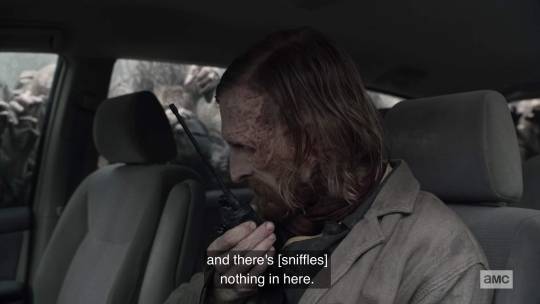
Something similar happened here. Dwight is alone in the car. He gives up, even looking at his gun as though he might shoot himself, but John and June talk him out of it. June tells him that giving up his search for Sherry would be just as ethically wrong as hurting someone. I think it's interesting that it's June—the once missing woman—who convinces the depressed man not to give up. Very Beth-ish. Then they help Dwight escape the van by shooting the walkers and creating a clear path for him. Much like Morgan did for Daryl and Aaron in 5x16.
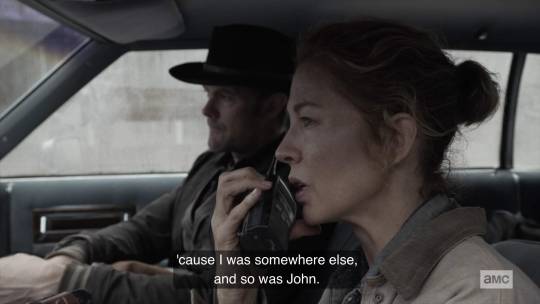
Some of the dialogue was also important there. June says Dwight doesn’t feel like he deserves to find her and find happiness again. Dwight says it doesn’t matter if Sherry is alive or dead, because he’ll never find her. Never be able to make things right. He says that’s “who I am now.” Making things right is a callback to what Daryl told him to do in 8x16. I also think this dialogue could apply to Daryl at various times after he lost Beth. Interestingly, “Who You Are Now” is the title of the first episode after Rick disappeared (9x06) so we have a connection between this arc and what’s happening on the main show.
The other thing that this really struck me is that Dwight gets a version of Beth’s suicide arc. It obviously wasn't as long or protracted as hers, but the difference between Dwight in this episode and Daryl in 5x16 is that Daryl tried to sacrifice himself for something noble (saving Aaron). He didn’t simply decide to give up and shoot himself. So, this felt a lot like Beth’s suicide arc in TWD S2. Back then, she really did just want to give up and die. Much like Beth, Dwight came through his depression with a new resolve to live and find Sherry. Again, very Beth-ish.
Another detail I didn’t catch until the second time through? Remember that colt .45 I mentioned earlier, which points to Andrea surviving her gunshot wound in the comics? It was that gun Dwight contemplated killing himself with. John gave it to him to shoot walkers. Coincidence? Yeah, really not.
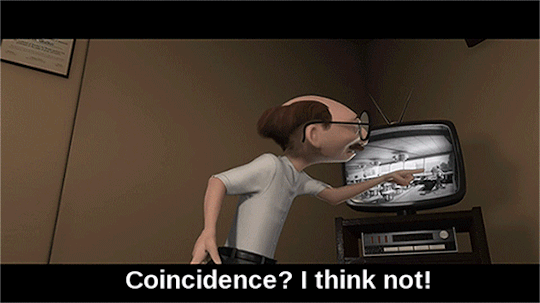
After rescuing him from the van, John tells Dwight he had the wrong car. He compared the VIN number on the registration to van’s VIN number, and they don’t match. Obviously, the make, model, and color of the van are exactly like the one Dwight was looking for, but he just so happened to find the wrong one.
I think all this car stuff is super interesting. Given that we think Beth was left in a car, and that we often see clues in car license place plates and car trunks, it’s just interesting that there's a car arc going on in this season of FTWD. Registrations have lots of numbers and letters in them. And the fact that he found the wrong car? I think that's significant. I wonder if something about this will end up playing out as part of Beth’s arc as well. They left her in the “wrong car” somehow. I have no idea, really, but it’s fun to contemplate the possibilities.

At the end of this episode, Dwight and Morgan meet and recognize one another. Morgan is instantly accepting of Dwight and he officially joins their group. One super-subtle thing I caught here was that Dwight went to Georgia before going to Texas. He just mentions it very briefly in passing, saying “Once she hit Georgia, everything seemed to drive her this way.”
No way that’s a coincidence. They could spin it many ways. Maybe Dwight already ran into Beth in his travels. Maybe he was wrong about Sherry going to Texas and will eventually return to Georgia. Maybe she’ll head back to Georgia for some reason and he’ll meet up with her then. Either way, this arc is subtly pointing back toward Georgia. And Grady, which we can only assume is still standing.
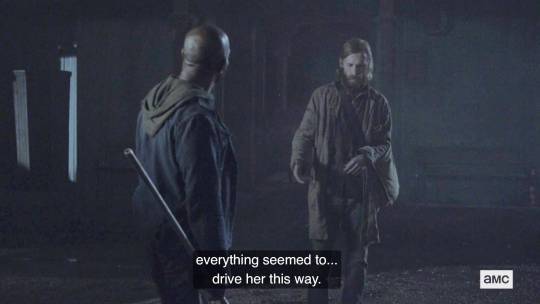
He tells them that he's never been inside the perimeter of walkers either, but he's walked all around it. He takes them to one particular place where they plan to break through and see what's on the inside. Just before they do, they hear something on the radio.
I haven’t mentioned Alicia’s minor arc this episode because it has less to do with Beth symbolism. She hears the kids they met in the first episode on the radio and keeps calling out to them, promising to help them in asking where they are. At one point, she hears Annie and Dylan talking on the radio, with Annie telling Dylan to hide because she can see “them.”
We don't know who “them” is. It's definitely interesting because it's the name of episode 5X10, so we could see it as another tie to Beth. It sounds like there are bad people that the kids are running from. In the end, the kids radio and ask Alicia to meet them at the truck stop where Morgan's group originally took them.
So, Morgan’s group doesn’t break through the Red Rover walkers right then, which means we can after little longer to see what's inside the perimeter.
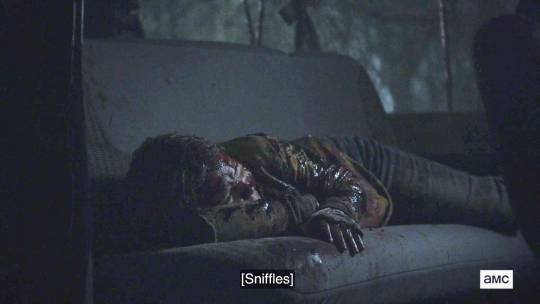
On the way back to the truck stop, they see the van the kids were driving. Inside, Dylan is laying on the seat. He looks hurt, or perhaps just sad. He’s covered in either mud or blood (probably both) so it’s hard to say how injured he is. But he’s alone. Annie and Max aren’t with him.
The most interesting symbolic thing about this is that we once again have Morgan finding someone inside a car who's hurt. It’s pretty much the biggest symbol of Morgan finding Beth in a car that we have, and we've seen it many times now. Alicia asks Dylan where his brother and sister are, but he doesn't really say anything before the episode ends.
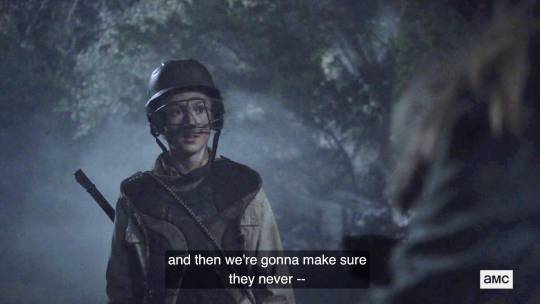
Then it cuts to Max and Annie putting up Red Rover walkers. So, as it turns out, these kids are the ones tying them across the roads. I'm of two minds about what this might mean.
The show implies there's nothing inside the perimeter of walkers. The kids just put them up to keep strangers away from the area. But I don't know if I believe that's true. Maybe these kids are just super- smart, but I don’t see them going to this kind of trouble to protect…nothing.
I also don’t think they could have put the walker heads up on the billboard by themselves last episode, and there’s still the question of who took Al. I don’t think it was them. In fact, Max says he wants to find out who took Alicia’s friend, so it wasn’t them. So overall, I'm not sure what to make of this yet. But it makes the mystery of this place intriguing and I'm excited to see where it goes.
So once again, we don't know if "them," is really a group of baddies, or just something created by these kids. I'm not even sure which one I hope it is. Having something crazy inside the perimeter of walkers would definitely be a cooler plot twist. But if there's really nothing there, the reference to Them becomes purely symbolic, which is good for us, too. Also, I’m wondering if the “humbug” in the title perhaps refers to the way in which these kids are deceiving Morgan’s group. Not sure how that will pan out yet, but it’s interesting.
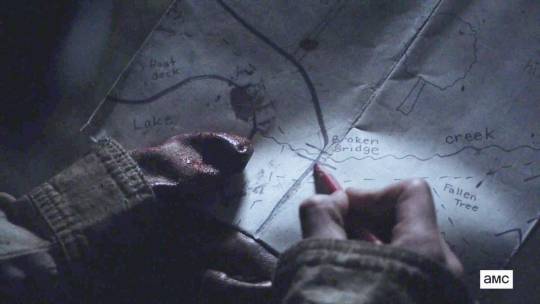
Some final symbols: we saw Max drawing on a map and I noticed it said, “Broken Bridge.” So, not only Bridge Theory, but I feel like that’s a connection to Rick’s bridge in TWD S9.
So yeah, I really loved this episode. Lots of fun set-ups and I'm super excited to see where this arc, both with Dwight and with this perimeter of walkers, goes. Because they used Xs within circles to represent the perimeter of walkers, I really hope whatever is within the perimeter will lead to Beth. Thoughts?
#beth greene#beth greene lives#beth is alive#beth is coming#td theory#td theories#team delusional#team defiance#beth is almost here#bethyl
10 notes
·
View notes
Text
Notes for Storming the Castle, Chapter 9
Hello again, dear AkaFuri readers! It feels SO nice that it hasn’t been too long since I last updated. I replied to all the Ch. 8 comments on Ao3 (YAY), but I did want to mention that I’m still planning to reply to several people who left me really nice notes here on Tumblr as well. Hopefully that’ll happen later today or this weekend, so thanks for your patience! (Also I apologize for the awkwardness of replying two weeks later... Family holiday stuff last week turned out to be, uh, a lot? //laughs) On to the notes!
Most of my notes this time are brief, since I didn’t have too much in the way of cultural info or setting inspiration that I haven’t mentioned already. But in the interest of sharing, here are some things I remembered…
(Cut for my usual rambling about Akashi’s house and previous fics and mental health and also THE SPOOKY STUFF/why KnB is a supernatural story anyway...)
The “Italian velvet” reference in the pillow fight
This is a really silly note that I’m including just to demonstrate how out-of-control my Google research gets… Here are some throw pillows made from Italian silk velvet, which was the fanciest imported fabric I could come up with for the pillow fight scene. (Because of course I managed to squeeze a pillow fight scene into my super-dramatic sleepover fic, haha. XD) And in case for some reason you want to know a little bit about the super-posh history of this fabric, I’ve got you covered.
(… Seriously, why do I look up things like that?)
The Akashi Family Portrait
The huge portrait of Akashi and his parents is something that I’ve been preparing to include in the story for a while… It was inspired by those gigantic paintings you often see in super-fancy European estates, that idealize powerful members of the aristocracy. (Or royalty, in some cases!) Since the Akashi house is a Western-style mansion, the idea seemed pretty fitting, as over-the-top and surreal as it is? //laughs Over on my Pinterest inspiration board for this fic, I included a bunch of different ideas for the gown that Shiori is wearing in the portrait. I especially like the color of this one and the overall silhouette of this one but this is spectacular as well. (Her gown probably wouldn’t be as low cut as those examples, for multiple cultural reasons, but you still get the general idea?) There’s actually a lot of Shiori-related inspiration in that part of the board, including a couple KnB images!
The Traditional Tatami Room
So this one is interesting… Back in Chapter Five, you might remember that Furihata’s house—like many Japanese homes—has a traditional Japanese-style room with tatami mats on the floor. Since Akashi’s house in the anime is based on an actual Western-style mansion near Tokyo, my initial assumption was that his house wouldn’t have any traditional rooms. BUT, it turns out the actual house does have at least one room with tatami mats, as you can see in the third photo from the bottom here. (You can also see a photo of it in the first link!) So I decided to include it in Furihata’s midnight exploration of the rooms, where he discovers the Akashi family butsudan.
I’ve mentioned butsudan in the notes in Part One, but as a quick reminder, a butsudan is a family shrine that is partly used to honor relatives who are deceased.
References to Fast Train
Since it’s been a looooong time since I posted the first story of this series, I did want to mention that a few of the things that Furihata thinks about during Part Two are referring to events that happened in The Fast Train to Kyoto. Furihata’s first dream about meeting Shiori is one example. Another one, in this chapter, is when Furihata sees Akashi’s father in person for the first time, and remembers that Akashi once told him that he “was instructed to keep people at a distance.” That’s from their phone mail conversation in Chapter Seven of Fast Train.
I try to make sure that any fic in a series can be read by itself, so I usually stop to explain these references in some way, for those who didn’t read the earlier story. But that one was vague enough that I figured it deserved a nod!
Photo References for the Bedroom
I linked some of these before, but since the final scene featured Akashi’s bedroom so much, I thought I would link a few of my photo inspirations for his bed here, here and here. Also, I forgot that he wasn’t wearing the robe in the previous chapter, so here’s a few photos I picked for possible inspiration there. (Those are both a little fancier compared to what I saw in my head, but I’m okay with that? //laughs)
Furihata’s Anxiety
I won’t go into panic attacks and anxiety here, since that information is pretty readily available online… But I did think it was worth mentioning that while Furihata has panicked in front of Akashi in my fics (and in canon!), he says that until now he’s tried to avoid having an attack that severe in front of a friend. Since this series is meant to be about two people who struggle with different mental health disorders, I think it’s noteworthy that Furihata trusts Akashi enough at this point to let his new friend be around him when he’s at his most vulnerable, and to see the full extent of what he struggles with.
(And I’ll also say that this is a theme in the series that’s going to come around again. I won’t say exactly how, because of the spoiler factor, but… I bet a lot of you can figure it out! Seriously, your insight about where the story is going constantly amazes me. <3)
All The Supernatural Stuff
To be honest, I have no idea if I should be apologizing or not, for how supernatural this chapter gets? //laughs Several people have told me that they’re still reading this series because they enjoy the idea of Furihata having supernatural powers, like the ability to see auras. So, uh… I hope you enjoyed this chapter? XD
I have to admit that from the beginning of A Spark of Light, I was planning to include various elements of the supernatural. (I was foreshadowing this in Fast Train too, so, see previous note? //laughs) That’s one of my favorite things about KnB, if I’m 100% honest… I’m obsessed with all kinds of fantasy and speculative fiction, so I love all the little hints in the KnB canon that something kind of supernatural might be going on with the Generation of Miracles. Like how Kuroko has absolutely no “presence” but the GoM have really strong ones, and how they all have that weird clairaudient vision of a door opening in that one episode, and… yeah. XD Even the more subtle stuff, like all the different patterns of matching names (no kidding, almost EVERYONE has names that match in different ways, even Seirin and the Uncrowned Kings!). Plus the way the GoM are the only ones with super colorful hair, and also Akashi’s slitted pupils? (SERIOUSLY WHAT IS WITH THE CAT PUPILS, WHY DOES NOBODY IN CANON EVER ASK ABOUT THAT.)
Come to think of it, I can go ahead and mention this now… The series title, A Spark of Light, is meant at least partly as a reference Furihata’s first name! “Kouki” includes the kanji for “light,” and one translation for its full meaning is “establishes brilliance.” (Light symbolism is super important in KnB in general, for obvious reasons. XD) So the title partly refers to how during the series, Furihata’s intuitive and supernatural powers are “sparking” to life, and this affects pretty much everything that happens. (And it’s one of the reasons why he is able to get so close to Akashi in the first place.)
Side note: This is loosely related to the reoccurring thing with Furihata (or a character that represents him!) holding a small light, like a lantern/candle. I also use a lot of fire symbolism for Akashi, because fire is pretty strongly associated with the color red in Japan. So one is the “spark” while the other is the “flame,” basically? METAPHORS. //I’msocornyohgodhelp
In any case, the supernatural parts are definitely becoming more and more important to the plot! Furihata doesn’t fully accept some of what he sees in this chapter, but I can say that he’s going to have to face some of what it means for him (and for his connection to Akashi) very soon.
(And hopefully I didn’t creep anyone out too badly with the ghost stuff… I know some of you definitely saw it coming! But with any luck, the way in which it was finally introduced had an interesting twist to it… I hope?)
As always, thanks for checking out my ramble-y notes, and thanks so much for reading the fic. <3 See you again soon for the final chapter!
#storming the castle#kat writes fanfic#kat writes about basketball dorks#long post#text post#thank you so much again to everyone who's let me know they're enjoying the story#you're all so awesome#and hopefully I didn't creep anyone out too badly???#except Furi#SORRY FURI DEAR IT HAD TO HAPPEN#also I continue to apologize for the sheer level of DENIAL of these two boys#all I will say for now is that the clock is ticking on that one#like seriously ticking#TICK TOCK
14 notes
·
View notes
Text
The Care and Keeping of Your Writeblr | Pt. 1 - Getting Started
Hello all, and welcome to my guide of possibly-useful, possibly-not advice for creating and maintaining your own writing blog and connecting with the online writing community.
I'm in no way an expert, nor am I the best, most popular writeblr out there. Not all the advice I post will work for or even appeal to everybody, but I'd like to share what I've observed and found useful in my own time running this writeblr sideblog.
This installment will be covering the basics of GETTING STARTED.
So you've decided you want to start a writeblr. Good for you! The writeblr community is a great place for motivation, inspiration, sharing ideas, getting feedback, collecting resources, and just having good old fashioned fun with other writers. It can be intimidating to try and enter into an established community, and it's okay to be nervous. But with few exceptions, this is a very friendly place.
Choosing your URL:
This is the first thing you're going to be asked to do when starting a new blog, whether it be a main blog or a sideblog. You'll want to put a fair amount of thought into this as it can influence the amount of traffic on your blog and changing it later can confuse your followers. This is the simplest, most straightforward piece of advice anyone can give you - put something about writing in your URL. It doesn't have to be some variant of 'writing' if you don't want it to, but consider different ideas related to the craft. Images of typewriters, pens, ink, etc. all bring writing instantly to mind. Also consider your genre. You could use an offshoot of that such as "name-does-scifi."
If you're making a sideblog, consider whether you want your writeblr url to be similar to your main URL. (That's what I did.) Remember that likes, follows, and comments will all show up as coming from your main blog's URL. It may help other writeblrs make the connection between the two, especially in your early days. This is of course just a matter of personal preference. Food for thought.
An effective URL will make it easier for others to find and connect with you!
Writing a Title and Description/Bio:
Once you've fired up that shiny new URL, you'll find a lovely white void awaiting you, yearning for all those lovely words you've got inside your head. First and foremost, you'll see big block letters that probably say 'Untitled' at the top of the page, right under the header image. Again, I suggest putting something about writing in your blog title. This is the first thing someone sees when they open your blog, and again it lets them know if it's likely to have the kind of content they're after. This isn't mandatory by any means - you do you - but it may help you gain traffic in the beginning. Some writers, like myself, simply use their URL as the title, others use the title of their WIP, and others put any phrase that strikes their fancy.
Under the title, there's a space for a description. Use this space to introduce yourself, your WIP (if you want) and your blog. It can be as vague, specific, serious, humorous, long, or minimalist as you like. Browse some other writeblrs to get an idea for what appeals to you. Remember you are under no obligation to share any personal information including name, age, or location. Your privacy is yours to protect in whatever ways you see fit.
As far as content goes, here are some things you may want to mention in your description depending on the kinds of posts you plan on sharing.
genres (young/new adult, adult, children's, fantasy, sci-fi, mystery, etc.)
original works or fanfiction?
are you open to participation in tag games?
WIP titles
writing tips, humor, encouragement
liveblogging your writing process/journey
guides, resources, and references
will you be posting much original content or mostly reblogs?
links to other accounts/pages (hyperlinks are supported)
If your writeblr is a sideblog, consider listing your main URL in the bio and your writeblr URL in the bio of your main. Many people like to follow back, but since they were notified of likes, follows, and comments via your main URL, they may not put two and two together without some assistance.
Makin' it Pretty:
It's what's on the inside that counts, that much is true. But we can't help but be attracted to polished looking blogs. Don't worry about being fancy right away (or ever)! Just think about making your blog look well cared for. How? Choose an avatar/profile picture, a header, colors and fonts, and a theme. (Also note that lacking all of the above, including title and bio, can make your blog look suspicious to cautious users.)
The mobile/in-dash version of your blog and your in-browser blog can be customized separately, but your avatar, title and description will appear in both. The mobile version will look much the same as everyone else's, with variations in font, colors, and pictures. Fonts and colors can be selected from the settings/edit appearance menu. You'll want to upload a jpeg for the avatar (which can be square or round) and header (which you can reposition). It doesn't matter much what these pictures are - just have them in mind so you can get them in right away!
The easiest way to make your in-browser blog look nice is to select a theme. There are several free ones available with an array of different features so you can get the most bang for your zero bucks. Many are color and font customizable as well and support links, pages, and widgets. If you install pages for your characters, your WIP, or whatever you want one for, people will be seeing those through the in-browser version of your blog. Themes make it easy for them to navigate! (Click on the paint palette icon to change your theme.)
Writeblr Lingo:
Writers are pretty much a subculture, and we speak our own jargon. Here on Tumblr, there are also extra terms you may want to be familiar with as you get started. Here's a basic glossary for your reference. (Some may seem obvious, but I make no assumptions.)
Writeblr: Write + Tumblr = writeblr; a Tumblr account focused on writing
OC: original character
WIP: work-in-progress
Ref: reference
Sci-Fi: science fiction
YA: young adult; a genre typically considered well-suited for an audience of ages 13-18 and/or centered around protagonists of ages 13-18
NA: new adult; a genre considered geared toward an audience of 18-30 and/or centered around protagonists of this age range (note that this is a fairly new genre and the associated age range is somewhat variable); often associated with transitions from young adulthood to 'real' adulthood in terms of lifestyle, personality, etc.
Mutuals: people who are following each other; ie you follow them AND they follow you
Tag(ging) Game: a game passed around via tagging other writers in the post; played in the text body; most have the name and how to play within the text body
Tagging: typing the @ symbol followed by the account's URL; typing @ will pull up a menu of suggested URLs that display the blogs' avatars and will update as you type
Bookblr: a close cousin of writeblr; this blog type focuses on reading published books and often includes reviews and recommendations
Rec: recommendation
Comments? Suggestions? Corrections? Additions? Let me know what you thought about this guide and if you have any ideas for future installments, which are coming soon. Happy writing, everybody.
#writeblr#writing#writeblr community#starting a writeblr#guide#tips for beginners#writers on tumblr#care and keeping of your writeblr#getting started#mischiefiswritten#new writeblrs#cak
100 notes
·
View notes
Text
What is Smudging and Why It Matters

“Since ancient times, our ancestors have burned sacred herbs and resins, believing the sacred smoke to raise vibrations, dispel of negativity, and assist with spiritual work. Today, we know this process as smudging, and it remains a critical first step in any sacred ritual. I smudge daily to purify my sacred space before ritual, ceremony, or meditation. It’s an integral part of my spiritual practice – in fact, it’s what this community was built upon! Sage Goddess began with my hand-wrapped smudge bundles, which I offered to those around me in the hopes of spreading healing, love, and light”.
How to Choose Your Smudge
It’s important to know that all plants are sacred, not just sage! Each plant carries its own magical properties and benefits, and you can pick one to resonate with your specific intention. If you’re feeling drawn to a specific type of smudge, trust your intuition – your spirit knows what it needs.
Click here to check out the smudge bundles, herbs, and incense that I offer on my website – you’re sure to find the perfect smudge for you! And read my blog to learn even more about smudging and how to incorporate it into your practice.
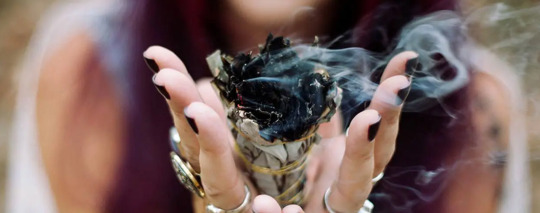
How to Smudge
First, light one end of your smudge, allowing it to catch fire and burn for several seconds. Once the flame extinguishes, gently blow on the lit end to fan the embers; the smudge will begin to glow and smoke. Lay the smudge on a heatproof dish, such as an abalone shell, to catch the ashes as it burns. We should always respect the power of fire when using it in ritual.
As the smoke rises into the air, picture your intention, whatever it may be. If you are clearing negative energy, picture its density and see it lifting away. Healing? Then imagine the smoke cleansing any illness or injury. Whatever it is, envision it floating away on the smoke. You can pray or chant if you feel called. Use your hands or a smudge fan to guide the smoke over yourself and around your sacred space. In my native Greek culture, we begin facing East, then turn South, West, and North before finally turning East again. After making this ceremonious circle, we douse the burning embers. I love honoring the cardinal directions in my smudge ceremony; it roots me into Mother Earth.
Native American ceremonies begin by sprinkling the floor with loose sage. They then burn the sage, a braid of sweetgrass. Finally, they burn a bundled sage stick (or smudge bundle), while washing the smoke over the body.
The beauty of smudging is that it can be done at any time, as often as you need, no matter your background or culture.
Sacred Herbs for Smudging
Listed below are some basic properties for various herbs I use at Sage Goddess and, of course, in my own rituals. These herbs have been used for centuries all over the world.
Alfalfa– associated with psychic abilities, and attracting animal spirits.
Allspice – for uplifting and increasing energy, and determination.
Amaranth – for healing, protection, vulnerability, especially healing of broken hearts.
Aspen – for ascension, protection, and overcoming fears.
Basil – for attracting love, happiness, peace, and money; steadies the mind.
Bay Leaves – for psychic power, divination, success, and money; invoking wish magic.
Blue Spruce – the symbol of pure intentions, generosity, and giving.
Calendula – for love and constancy.
Catnip – attracts good spirits and great luck. For love, beauty, and happiness.
*Cedar – banishes fear and enhances psychic powers.
Chamomile – for protection and purification.
Cinnamon – when burned raises high spiritual vibrations and aids healing.
Cloves – for protection and exorcism; attracting opposite sex.
*Coastal Sage or Artemisia Californica – for clearing negative energies and healing holes or tears in the aura.
Dandelion – for divination, spirit calling, and wish magic.
Dill – for protection, luck, money, and lust.
Eucalyptus – for healing and protection.
*Frankincense resin – reduces stress, eases tension, and connects you with Source energy.
Ginger – adds power to any magical activity, speeds things up; brings passion.
*Lavender – brings peace, relaxation, and restful sleep; purity and love.
Lemongrass – for cleansing and purifying, removing obstacles, and opening doors.
Lilac – for protection and exorcism.
*Mugwort or Artemisia Vulgaris – brings clarity and develops/deepens psychic abilities.
*Myrrh resin – for physical healing and grounding.
*Palo Santo – for deep healing to the physical body; can be used to clear a home of energies associated with illness.
Peppermint – for purity, protection, release, and renewal.
*Pinon Pine resin – protective, healing, and nurturing.
Rosemary – for removing negative energies associated with sickness, and clearing.
Sage Flowers – for cleansing and releasing negative energies; brings wisdom and purity.
*Thyme – excellent for releasing ceremonies; allows us to recall the past without pain.
*White Sage or Salvia Apiana – used to clear negative energies from objects, space, or people.
*My personal favorite herbs.
https://www.sagegoddess.com/how-do-i-smudge/
0 notes
Text
Cells at Work! 13 (FINAL) | Double Decker! 2 | Slime Datta Ken 1 | Run with the Wind 1 | Bakumatsu 1 | Zombieland Saga 1 | DakaIchi 1 | Radiant 1 | SSSS.Gridman 1
Warning for discussion of 18+, potentially triggery things within the DakaIchi discussion...and the nature of that show being a yaoi will tell you whether you want to read that discussion in the first place. (There are full stops and lines around it in case you want to dodge that particular part, since Radiant comes right after it.)
...Otherwise, have at it.
Cells at Work! 13 (FINAL)
Apparently “distal” just means your extremities…
For some reason, I already knew about the fact that you can die from losing one third of your blood…because I read a Tumblr post that was meant to be for action writers and it was about blood loss.
…Huh? Was this a blood transfusion? That would explain why these new RBCs are so clueless about our RBC. Update: Yup, guessed it.
Come to think of it, there’s a WBC Nendoroid and a Platelet one but no RBC. That’s a bit disappointing…
The WBCs using that wobbly stick thing in the background are amusing, eheh.
Anyways, that was fun, even if I did get used to the routine of RBC getting lost and WBC fighting antigens in the end. See you next time!
Double Decker! 2
We’re now properly in the fall season, and of course now that the first drop’s out of the way, we’re starting with the best show this season (at least for the moment).
So does that mean if we’re NEETs we’re not paying for these detectives…? Is this an incentive for people to pay their taxes (LOL)…? (Okay, I’m kidding, I’m kidding. Sheesh.)
DD Partners…? Sounds…uh, partnery, considering what DD stands for.
Why is Travis blinking so much when he’s apologising…?
Snarky narrator is fun. I thought it was Kirill during ep 1 (or at least, it was for a bit), but now this narrator’s talking too much in 3rd person for it to be true. Maybe…it’s future Kirill. *collective facepalms from the peanut gallery* Or maybe it’s Kirill and a narrator, and Kirill will then break the 4th wall somewhere.
Now that’s monkeying around…LOL. *gets pelted by tomatoes* Oh c’mon, can’t I get in a decent joke around here?!
Well, as much as the can thing Doug does to Kirill is tropey for anime, I gotta admit this ain’t monkey busin-eh? You want me to stop with the jokes? Aw. Fine then, I’ll stop…
There’s something utterly relatable about having gone down the path of your dreams, only for it not to work out. In fact, I think I’m going down that path right now and I need to decide where to head next. That’s why I’m watching this episode right now – to make sure I don’t regret my future, by focussing on the present with a good anime.
According to this link to Google Books I got when I googled “ignis” and “desperatio” together, this might have something to do with a Panegyric of the Saints…something to do with hell, worms, fire and despair…? Uh, wuh? Am I just investigating this the wrong way?
Sanctus Bridge? As in “sanctuary”? Wow, that’s…ironic.
The rabbit police mascot…you can see it on Deana’s dashboard, LOL. Plus the bird police mascot that goes with it.
The name shots you get of these criminals aren’t nearly as good as “dick suck” (sic) in Kekkai Sensen, but they’re pretty close. Plus they actually do have correct Japanese translations, unlike “dick suck” (LOL).
Seriously, what’s up with Doug’s head prodding? Is it to stop him from trichotillomania (which is the pulling out of hair)? I can see it getting vaguely annoying when the excitement of a new season wears off…
The CGI is kind of awkward in this. You’d need to stare at it for a bit to realise it’s CGI and it’s not the worst effort I’ve seen (*grumbles* Tsukigakirei *grumble*) but it’s still pretty bad…
Oh! Those doors! Is Doug’s car…a DeLorean? (dramatic piano SFX in background)
Was it just me, or did Kirill’s face go funny for a second as he was moping about how he didn’t get to do anything…?
“Let me be your Double Decker!” – That’s what he says as a double decker bus goes by…clever wordplay, huh?
“One is poverty. The other is class.” – Okay, my studies tell me that’s pretty much impossible. Even in social situations, you have a clear leader and subordinates. Poverty is fine and dandy in regards to giving the boot – heck, that’s why things like the Millenium Development Goals exist (or rather, existed in that case, since those were replaced in 2015) – but class? That’s a bit of a difficult one, unless you want to resort to hardline socialist methods, Marxist methods…or communist ones. Not that any of those are bad, it’s just that I happen to like capitalism,even with its flaws and no matter what imbalances it causes to others. It’s just that not having capitalism would mean everyone’s equal, but then everyone’s worse off as a result…because if everyone has the same stuff, no one is different and no one is diverse enough to make anyone special. Get what I mean?
I think this episode sold me even more on the show, the premise…the everything. Except maybe that “I want to get rid of class” part.
That Time I Got Reincarnated as a Slime 1
I just memorise this show as “Slime Datta Ken”, so if you’re wondering what that is…now you know.
What was that opening segment for, man…? This is just a boring isekai intro.
I’m laughing! He values his computer over his life? As much as I know I’m attached to my computer, you should prioritise 1) getting Mikami an ambulance, 2) stopping the blood flow or 3) just getting Mikami to preserve his own life. Not that I’ve ever been in a life or death scenario, but that’s common sense, even if it’s a bit nihilistic or unrealistic.
Seriously, there’s currently no pull but how intriguing these unexplained “acquisition” scenes are. Like seriously. Those effects are cool and somewhat intriguing in the same way as Juuni Taisen was.
The picture of a flower…where did it come from? A child? Hmm, interesting way to express such a though process.
The CGI of the reveal was actually really good. Like, Houseki no Kuni good!
Actually, this is very Houseki no Kuni. Reestablishing what it is that makes humans human and what causes a creature to live and all that.
I never knew a slime could be this expressive…
“I see you have guts.” – That’s probably something you shouldn’t say to a slime, LOL.
Oh! This reminds me of a writing piece I had to do one time where you had to tell a tale from a monster’s perspective and make them sympathetic. I wrote about a dragon, so there’s something nostalgic about this.
There really isn’t a lot of movement in this show. Not that I mind it – Juuni Taisen I used to love a bunch and that was based off a novel, but this is an LN-based show…the level of writing in this show is clearly from the LN camp, for one thing. How it got such great production values, however, is another question entirely…
The slime and dragon friendship that just formed made me wanna go “ET!”, just because the gesture they did to seal said friendship did kind of look like that, haha.
Mechasoft Doors MX…hey, I am getting my fix of anime OSs this season after all! Just…not in Gridman yet. Update: There are zero OSs in Gridman, not in episode 1 at least...
Oh wow! That fight scene was so darned cool! It makes me wanna see more already! And the fact he (I already know from promo material the slime’s name is Rimuru) uses his slime form and human form interchangeably…that’s even cooler!
The font down the bottom and up the top of the next episode box appears to say “Tensei Shitara Slime Datta Ken” (due to the frequency of one of the symbols that appears to be an S, then you do the same for E and you realise it works…then you realise the text is just stylised romaji). There are zeroes and ones on the left and right sides, which might correlate to Rimuru’s “analysis voice”…whatever that may be. Anyways, I’m pretty confident this’ll be something for my lineup, but it’s too early for judgement calls. It’s a keeper…for now.
Run with the Wind 1
Now here’s a show I didn’t expect to follow going in…I picked it up merely on ANN recs.
I’m laughing like a maniac! As much as it was a compelling opening, after the dude arrives on his bike and asks “Do you like running?” to a thief, I lost it. For some reason, I find it almost so unrealistic it became hilarious, in a stupid sort of way. Or maybe I just have a really bad sense of humour. Who knows?
That one guy running in the back in the OP is basically me every time I’m meant to do something physical. Even going up three floors via stairs gets me out of breath though and I live a fairly sedentary lifestyle, so I ain’t a good comparison.
That nickname “Shindo” puzzles me. I can’t think of a kanji combo that would result in wordplay with the characters for “god” and “child” using the name “Takashi Sugiyama”, but I guess maybe we’ll find out in a later episode…?
Thank…uh, goodness for the censorship on Musa…
Musa speaks unusually politely (because I noticed he used “gozonji desu” at one point, which is a keigo variant for “shitteiru”). Maybe it’s because they barely know each other that there’s keigo being flung about. That seems reasonable, at least.
There’s something authentic about this sense of camaraderie. I can tell because my extended family is huge, so gatherings are often like this but multiplied in scale.
“Tsuru no Yu” – Technically that translates to “Crane’s Bath”…”Public Bath” is the place’s purpose.
I was wondering why we’d somehow reverted to not having 10 dudes, but then they show this is actually Haiji’s perspective of the event from the start of the episode and show the scar on his knee. That’s gotta be important for later.
…and Haiji left his towel, LOL.
I still laugh every time I see Haiji’s stupid face (the one he makes when he asks “Do you like running?”).
I’ve associated the slurring of words like “yakusoku-ssu” to be for smol bishies like Yumoto, so having Haiji use it is a bit of whiplash. Then again, apparently that slurring is only used by men to assert their masculinity as far as I know…so, uh, yeah.
Actually…I’ve been wondering. How long are courses at this uni? Where I am, being a straight literature major is 3 years (assuming you also do other stuff that fulfils a straight Arts degree). Also, Fune wo Amu (by the same creator) is about a dude making a dictionary…hmm, so the creator really likes books.
Wait, as far as my short term memory operates, most of these guys at Chikuseisou do arts majors, aside from the law student and the smoker (who does engineering). They do literature or sociology, mostly. So if that’s correct…the author also likes sociology. I’ve been thinking about doing some sociology myself, it would really complement what I know about international studies.
As explained by Kyra, chiku – sei – sou. The sei means blue/green and the chiku means bamboo. Switching the two and reading them differently gives you “Aotake”.
Rent’s $300? Must be cheap, eh?
Also see Kyra’s post for information about the food-based suicide note.
The Kanto Gogakuren refers to this manga, Sakigake!! Otokojuku. It’s basically Again!!, but with more Fist of the North Star-style dudes.
Hmm…turns out you can refer to this show as KazeTsuyo. That’s going to make me confuse it with SekaTsuyo, though…(SekaTsuyo = Wanna Be the Strongest in the World!) Also, it turns out the character for “Kakeru” in this case means “to run” (normally it means “to dash” with a kanji normally used for flying). Wait…did I ever mention how much this show’s aesthetic visuals always look as if they’re a Powerpoint theme (see images below)? They do look like that, don’t they?
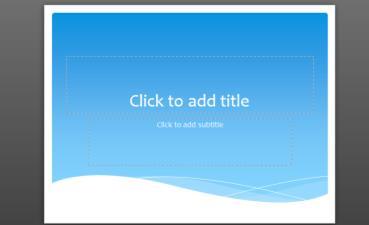

I still have no idea why Kakeru has a bad case of resting b**** face, but…uh yeah, forget I said that. The sound direction in this show’s really nice. It really takes advantage of quiet moment to insert natural sounds.
I think if you go “yes!” when Haiji says “I’m going to win over all the dudes”, then you’re sold on the show. I did go “yes”, just without speaking. You know those feelings you only get in your gut and heart? Yeah, like that.
Huh? I noticed a dude called Bruce Chiou is in the credits and he’s definitely on RErideD this season too…
Out of this one, Slime Datta Ken and Double Decker it’s ranked last, but this show’s still a pretty strong addition to the seasonal lineup. Only time will tell if I kick it out or not…
Bakumatsu 1
The only experience I have with this era in anime is Bakumatsu Rock, I think…and that means I don’t know much about it.
Actually…considering the OP, scratch that. I know a bunch because of Touken Ranbu and other similar historical shows.
A…boob window? On a man? I get the black skintight vest is meant to be sexy, but I can’t see the point of that diamond…it’s just something extra for the animators and the illustrators to deal with.
C’mon. Can we not have Dudes Swishing Their Swords at the 4th Wall as something meant to hype up the audience? It’s a cliché, almost as bad as the running scenes you often get in OPs and EDs…Seriously, I can’t believe I’m getting mad at 10 dudes swinging their swords like this (specifically I’m getting mad because they were all in succession – doesn’t matter if it was in time to the music or not).
Okay, who transplanted WWI into this? I know that’s the point of the show, but the sepia really sold the idea of “this is meant to be Old-Timey Wimey Stuff and whoever’s meant to be watching is meant to be a history buff so they can spot the difference”.
Part of the ep title is “Mou Ichido no Bakumatsu”, so a better translation is “The Bakumatsu (Era) – Again!”
Wait, I thought Kondo was meant to look hotter than this (especially because he had what appears to be a coin – or an old-timey family crest – on his head). The frumpy mouth doesn’t sell the goods, yo.
Somehow…I knew Katsura would have glasses. He has them in Bakumatsu Rock. But is it historically accurate to have glasses in the Bakumatsu era, though?
Come to think of it…something that controls time would be pretty hard to destroy, no?
I think I read on ANN that swords being too big to draw in ship quarters is accurate. Hmm.
If this is such an important treasure…then why not have more padlocks on it? Or more guards closer to it (although those guys probably ran away)? Or some other protection around it? Couldn’t this supposed Yoshinobu-sama fight for himself?...Then again, I think this is just a case of overthinking. (insert MST3K mantra here)
Puh-lease. As much as I want a kunoichi (lady ninja) in my shows, don’t make them Naruto run. That’s one of my pet peeves…
Uh…Hagi? That’s probably it, considering there’s a river in the show.
Kakesoba.
Kamaboko.
Tanuki soba.
Well, there’s something to be said about being able to steal Shinsengumi jackets while the men are eating noodles. At least it didn’t involve knocking them out though (weak LOL).
Okay…why do the Shinsengumi look like waiters now? As much as I like a dude in a waiter suit, if I wanted a waiter, I’d go to a fancy French restaurant…
I feel like I’m being clubbed over the head with themes in this show. C’mon, have more tact than that.
There’s basically no chemistry between these guys (Katsura and Shinsaku). How did they meet?
Wait, so Darker Blue is Sakamoto if Green is Katsura and Red is Shinsaku? Sakamoto (Ryouma) is the redhead in Bakumatsu Rock, isn’t he? Okay then. But who’s White?
Seriously, Shinsaku. Learn from the kunoichi and stay quiet and stealthy. I don’t need another shonen hero…
Oh man, Toshizou is normally one of the Shinsengumi I like best (or at least I recognise his name more) out of these kinds of shows. If he has Perma-Scowl, I can’t possibly like this version.
Oh goodness. Souji’s a friggin’ sadist. Come to think of it though, I think this (Okita) Souji looks like the one from Gintama.
Why does Toshizou sound a frigton like any given Touken Ranbu sword…?
If that katana is symbolic…Toshizou must be hecka masculine, LEL. (Note: A “LEL” is not quite a LOL, it’s mostly done in jest. If anything, it’s probably about half a LOL.)
If that blonde ain’t Abe no Seimei, Yoshinobu-sama or some other important historical figure I know the name of, I’m eating my hat! (Not that I’m wearing one, it’s a figure of speech.)
I like Sakamoto’s face here, but man, I get distracted by the man candy below it…(i.e. his abs and bare chest, LOL. What did you think I was referring to?)
Oh great. (sarcastic) Sanada Yukimura almost always has that silly helmet, ever since Sengoku Musou I’ve pretty much tried to run away from it. I’d recognise it anywhere.
Who had the grand idea of letting Sanada keep his horse, anyway?
Okay, as much as I like making snarky comments, I made one too many here, methinks. Time for the drop pile.
Zombieland Saga 1
I read spoilers just a little bit, so I know the main twist is “zombie idols that sing death metal” already. If you didn’t want to know that at this point…sorry.
Whoa! They killed their protag off the bat? Not that I didn’t know that wouldn’t happen (already knew it would), but that’s gutsy. Truck-kun, go back to your darn isekai shows already.
Okay, I know this is a schoolgirl, but can we not with Sakura’s Schoolgirl Run for Dainty Ladies? This is a zombie show, dangit. Run properly. Can we also not with the boob jiggle?
Well, that’s one way to defeat a police officer (or get yourself arrested): Spade to the Brain.
Otsumami appears to be the name for the squid in Kotaro’s pocket.
You can’t see Kotaro’s eyes, even behind those sunnies…hmm…
Wow. Miyano sounds like he’s having such fun voicing Kotaro, y’know?
From the flyer: “They are coming soon from the underground...” Yup, that’s right, alright. Zombies have already come from the underground.
Tae’s credited under ????. They’re still holding out on us!
It seems like a pretty good keeper, provided you can keep up with who’s who.
.
..
...
DakaIchi 1
Yep, the BL anime. Thought I’d never try one? Think again.
As much as I do think I’d want to be hugged by Takato, his face…makes him look like he came out of Junjou Romantica…? Uhh…awkward.
Please don’t let this be a work full of sadism and BDSM. I’m not that kinky, y’know…?
Uh, if you ever knew “boundaries”, Azumaya, that would be great. Thanks.
LOL, what a way to win a dude over. $10! That is cheap for a star.
I’m still wondering if this all constitutes “assault” or some other illegal business. I mean, Takato agreed to everything under the influence of a bunch of drinks.
LOL, the director’s shirt says “concentration”. As in, “focus on the stuff you’re doing”.
Hey wait, how does anyone pull off a kabedon on an operation curtain?!
Uh…maybe it’s just my inexperience with the genre, but…what the heck was that scene with the feathers?
Dangit, Yaoi Hands. If I weren’t so aware of you already, you wouldn’t be breaking the immersion of this show!!!
Random Dance Ending? I so did not expect that, I’m laughing as a result.
Uhh…I cannot believe I did that. I watched an episode of a yaoi anime and coveredit without it ruining my pride! To think I watched 18+ shoujo ai before 18+ shonen ai is really something I cannot get my head around, though…not that I will ever tell you which shoujo ai show I watched. So…uh, it was actually pretty decent aside from the “I don’t get what the heck this scene is meant to be” bits which are probably staples of the genre.
...
..
.
Radiant 1
Uhh…why do I feel like I’m watching Deltora Quest for the 3rd time? Not that Deltora Quest is bad, it’s just too stereotypically high fantasy.
Mahoutsukai. Literally “mage”, but could be “wizard” or “sorcerer” if you went with it loosely. Then again, the French word for sorcerer must be pretty close to the English one which should be enough of a guide for translators, right?
Eh? It’s an…elephant –cow? What is this, Avatar the Last Airbender? (half-snarking)
I think as the show goes along, its comedic timing is actually getting…better. That’s something, huh?
The show’s just a tiny bit too heavy-handed with its themes of racism or whatever sorcerers stand for. Then again, this is a shonen show. It’s allowed to be this way.
Geez, stylised English really is the order of the day for anime these days, huh? Lessee here…Alma’s…uh, Observatory, I think it says…?
Uh…all this talk about grimoires is giving me bad flashbacks…bad, screamy flashbacks involving a certain Asta…
I just noticed Alma gets referred to that way by Seth. Are these two not related, even though they share the same house (?) and hair colour?
Oh great. (sarcastic) Toilet humour. One of my worst enemies, aside from fanservice…
What’s up with the bat (?)? It knd of seems to be Alma’s…
Hey, I…think I know this kind of story too well. It’s going to eventually end, after a long run, with an adult Seth and that girl from one of the key visuals together…or something. Shonen are weird like that. They always end with a happily ever after and an adult protagonist, or the “the adventure just keeps happening!” sort of thing…y’know?
The plural of Nemesis is “Nemeses”, but it seems the book Seth read said “Nemesis’ Egg”. So the plural is the same as the singular in this case.
Huh? They chose to put both fancily-written French and then Japanese under it, as a homage to the French origins of this work? Huh, interesting.
Tommy’s saying “Gyaaaaah!” not “Yaaaaaaah!” - there’s a difference between those two, y’know?
SSSS.Gridman 1
As a self-professed fan of heroes who never actually got into tokusatsu because I keep missing Power Rangers when it airs on local TV stations, this and Garo are filling in a genre space I never really had until I started wandering tokusatsu wikis...which was before the live-action Power Rangers came out, methinks.
Why do I feel like I’ve seen this font (the one “SSSS.Gridman” is written in)? I thought it was a Calvin Harris music video, since I have a few downloaded legally (due to a CD I found in one particular library), but Harris’s font is slightly different to this one…Well, after some experimentation, it seems to be Arial with extra kerning.
“Amnesiac” is starting to become an anime trope in itself…
Seven-Two-One, LOL.
Ahh, children in puberty. Can’t tell whether relationships are romantic or just platonic. (wistful)
If Utsumi isn’t the goth dude from earlier, I’m eating my hat! (Not that I’m wearing one right-oh, I’ve used this joke before, haven’t I?)
…dangit, now I have to eat my metaphorical hat. By the by, I thought Utsumi was an Ume sort of character (as in, the type who would usually get voiced by Yuichiro Umehara), but no, it was Soma Saito.
The girl with the purple hair reminds me of the Administrator (or whatever her name is, the AI) from Yakusoku no Nanayamatsuri.
Regardless of whether the scene was with volume or not, that awkward pause between Shinjo, Utsumi and Hibiki went just a weeny bit too long…
When Takarada approached Utsumi and Hibiki, the colours of her earphones and eyes really popped!
They seem to treat memory loss as something minor, like a cold. It’s a bit awkward, I think.
Utsumi, kid. If you think computers from the 70s and 80s are huge, you should see server rooms! Those computers are huge! Not to mention, the first computers filled up entire rooms (just like servers do). Even portable server units are about a good 160 cm tall with wheels…oh, you don’t want to hear me prattle on about this? Okay, moving on.
“This really is a pile of junk, huh?” I had to go back and check someone hadn’t skipped a word – they did skip the word, in fact.
T-This is what Trigger have held out on us for? A monster like this looks terrible in CGI, man. Even if it is one of the better efforts. I mean, the eyes don’t even look in the same direction…
Why does Utsumi refer to the computer as “Junk”?
The Ultra series? Y’mean Ultraman?
Let’s just say…Gridman looks much better than the kaiju here.
They didn’t even dispose of the kaiju head properly, LOL.
I feel like the battle didn’t quite get my blood boiling. (Probably because I was grumbling too hard at the kaiju and the parts where the execution got a little too silly.) I’ll put it on hold and see if it gets better in a few episodes, but I’m not holding my breath. Since this is Trigger, it could pull off some great stuff if it tried…it’s just this seemed a little soulless in comparison to everything else I’ve seen them do. Or maybe my increased consumption of anime this year has left me jaded...
#DakaIchi - I'm Being Harassed by the Sexiest Man of the Year#Tensei Shitara Slime Datta Ken#Kaze ga Tsuyoku Fuiteiru#chesarka watches hataraku saibou#double decker! doug and kirill#hataraku saibō#DakaIchi#that time i got reincarnated as a slime#Bakumatsu#Zombieland Saga#simulcast commentary#Radiant#SSSS.Gridman#run with the wind#Chesarka watches ZLS#Chesarka watches Double Decker!#Chesarka watches SSSS.Gridman
1 note
·
View note